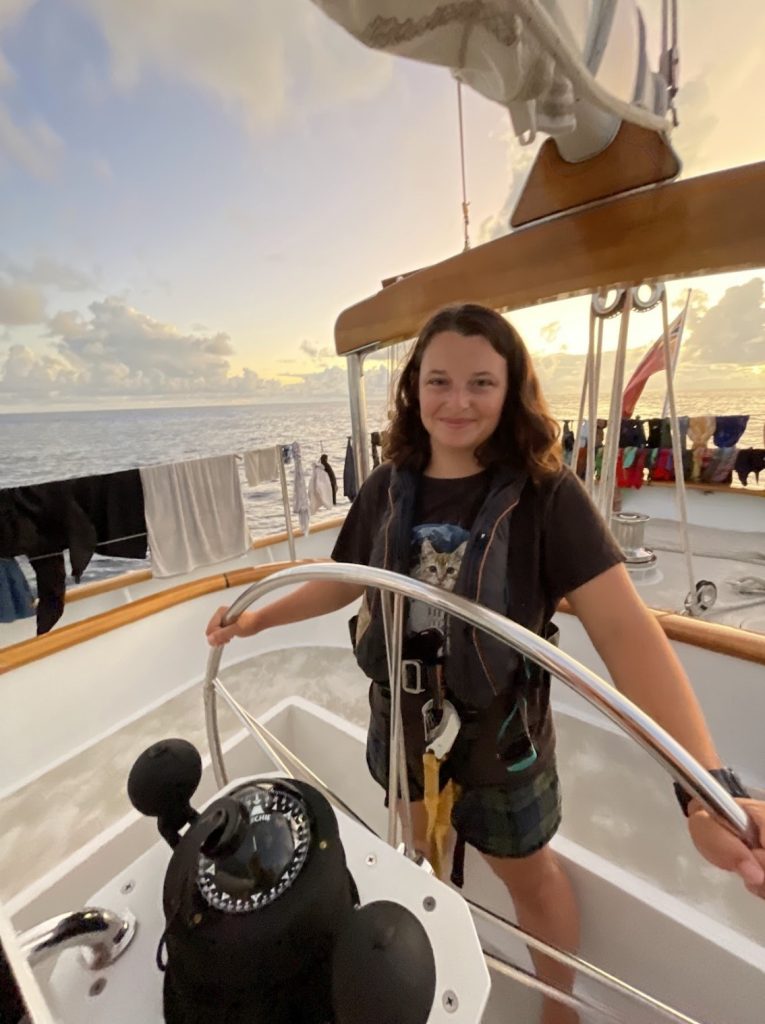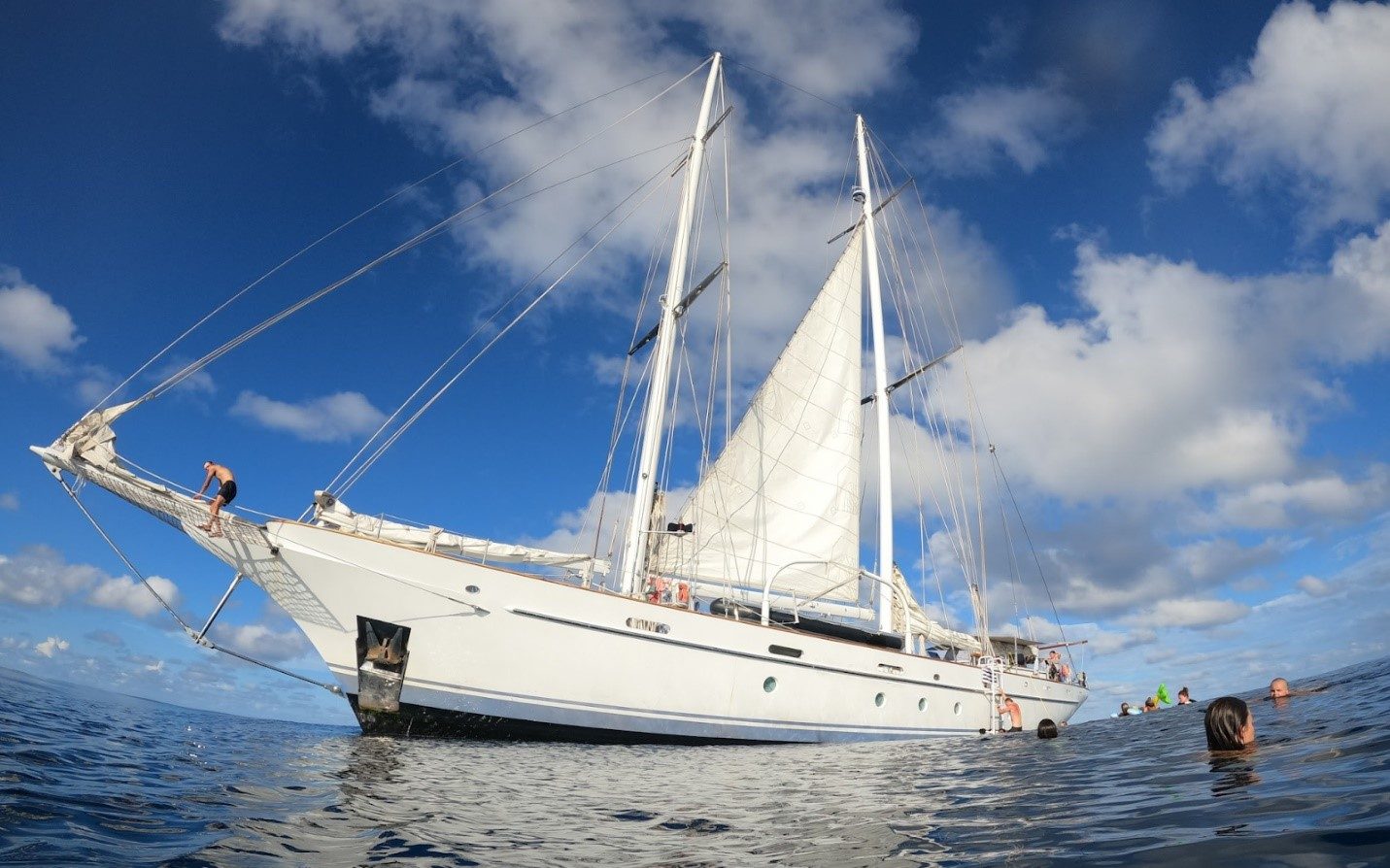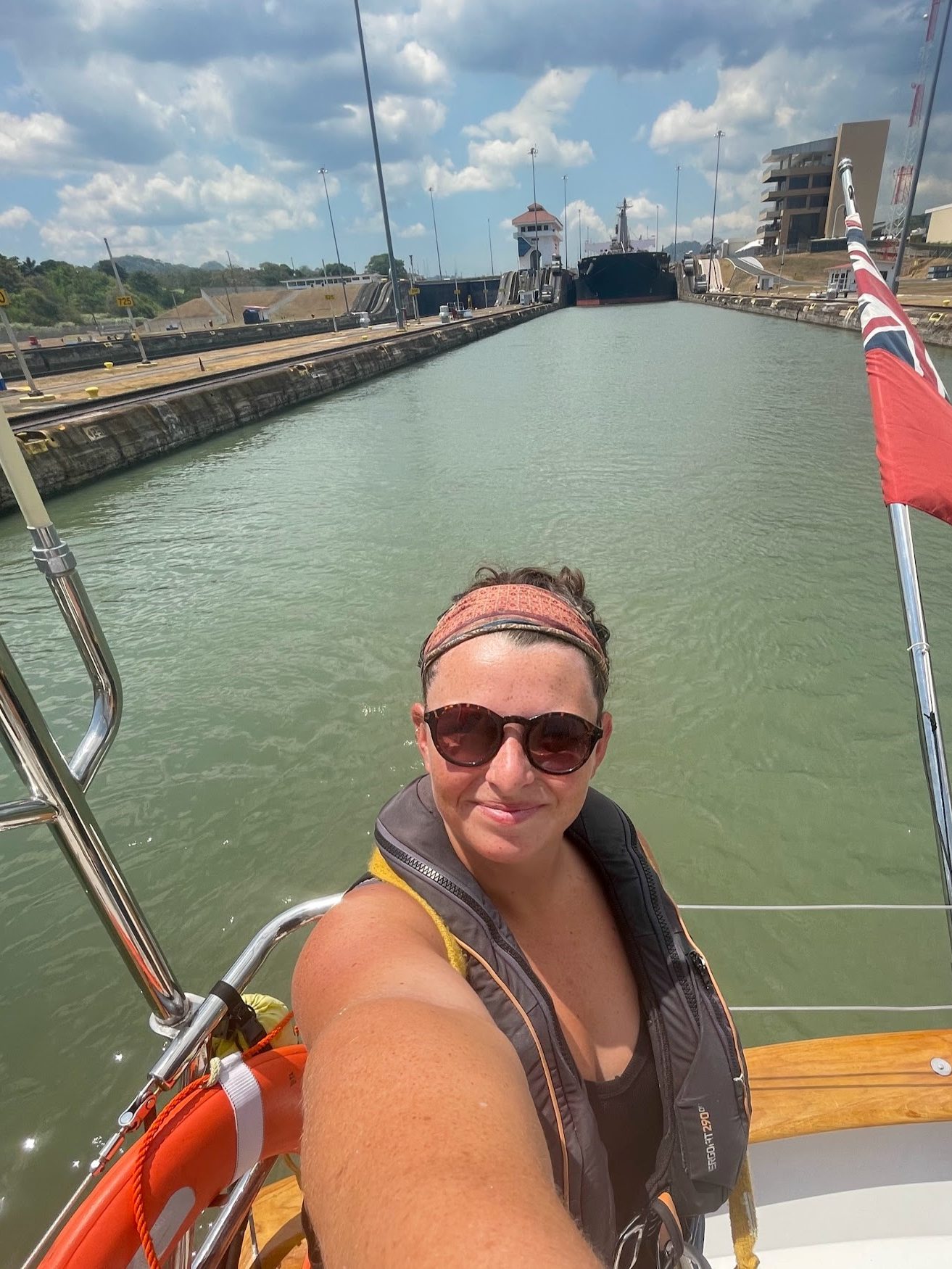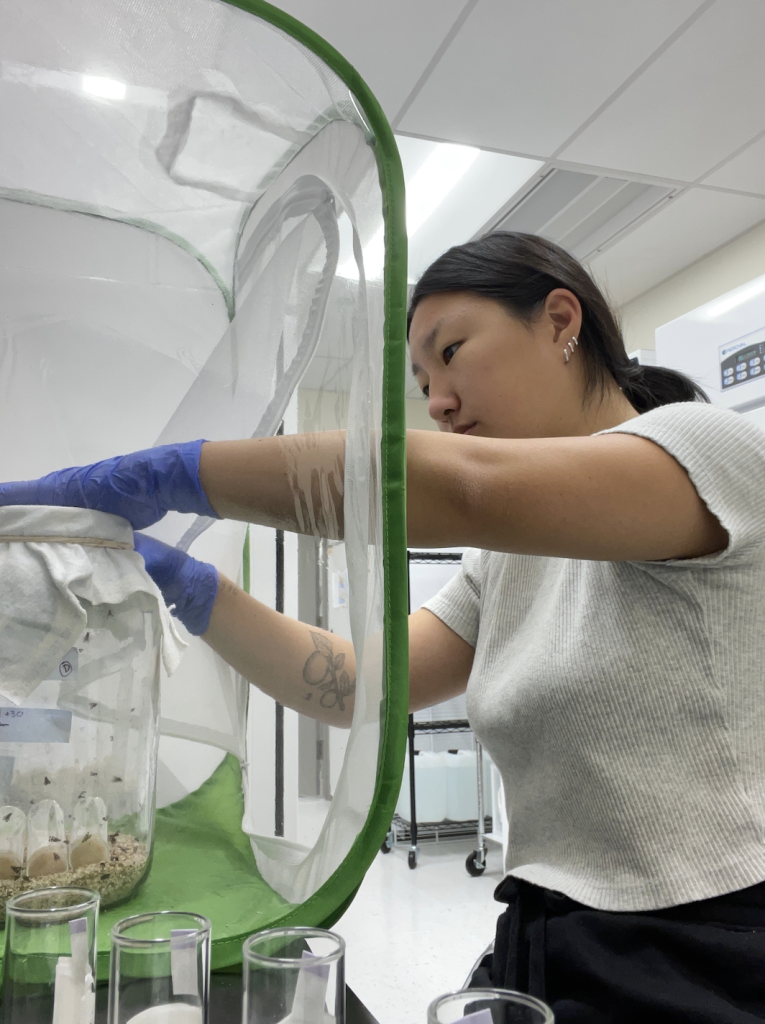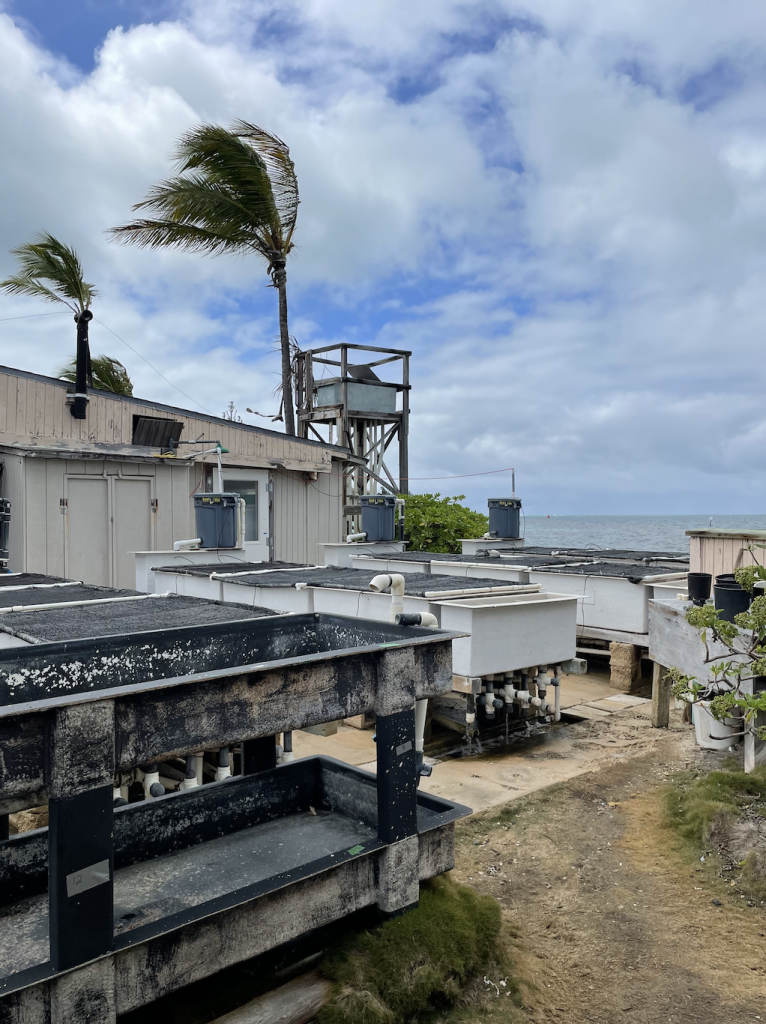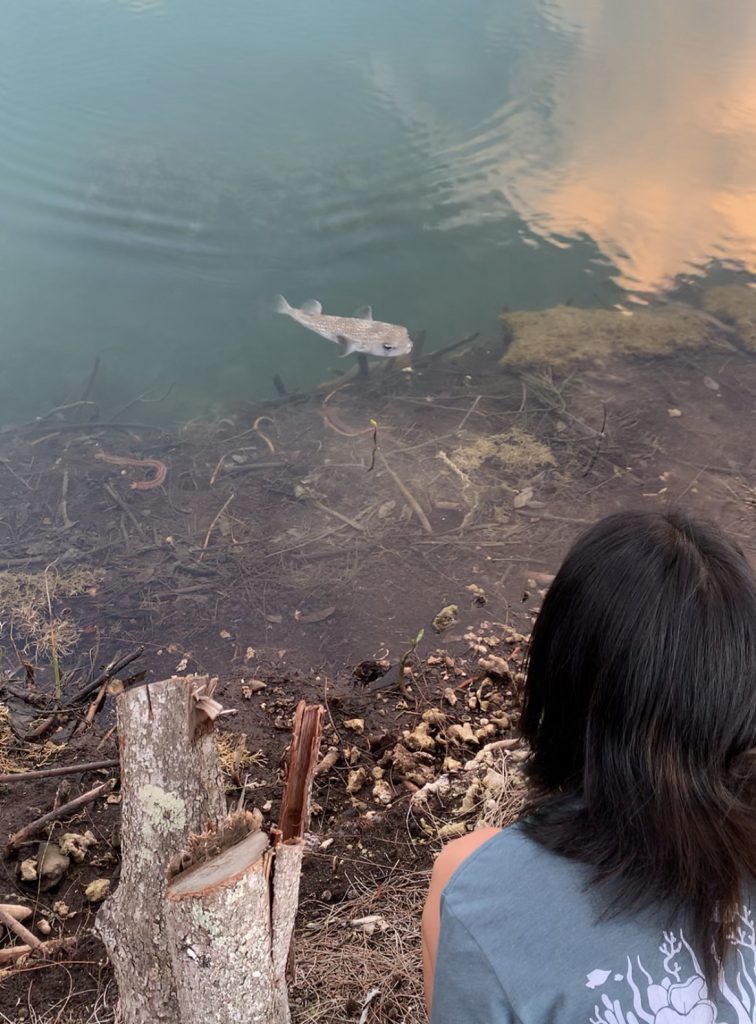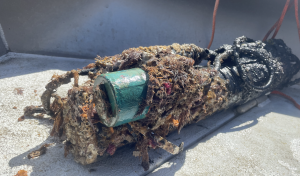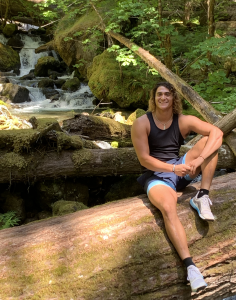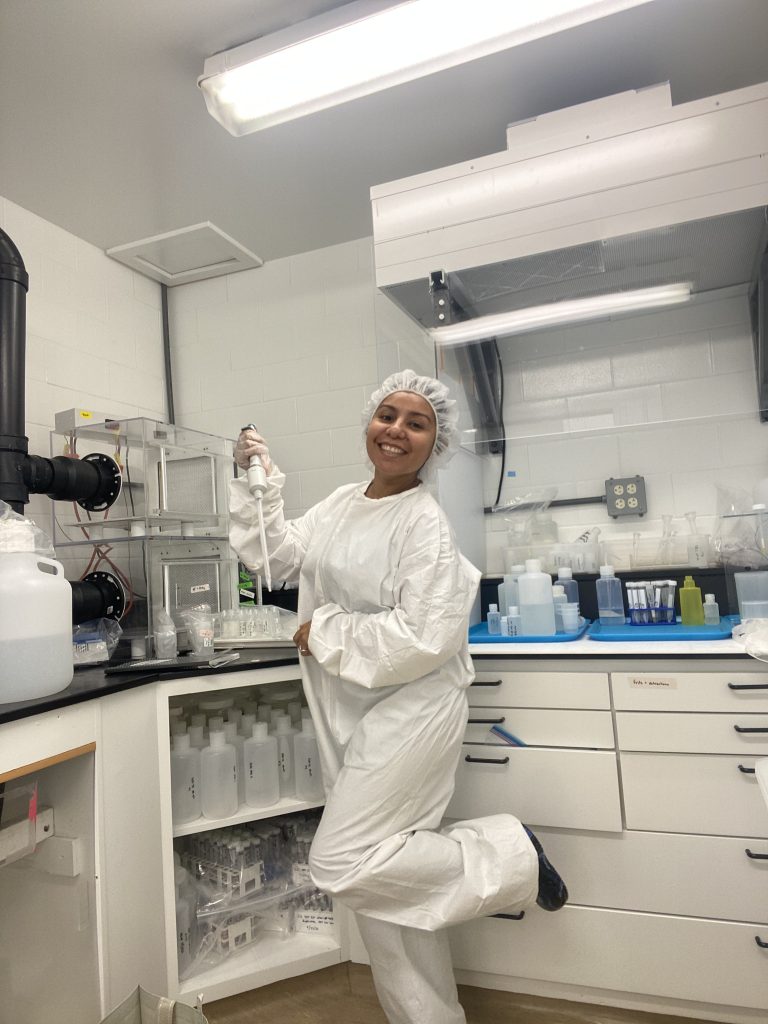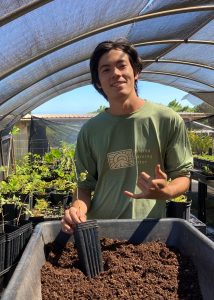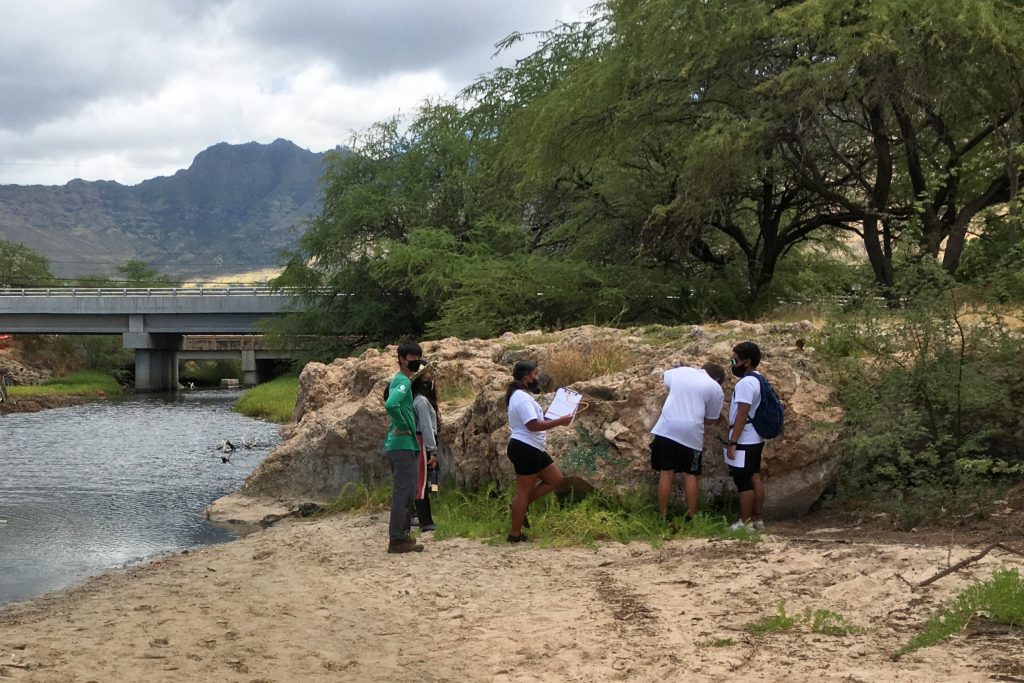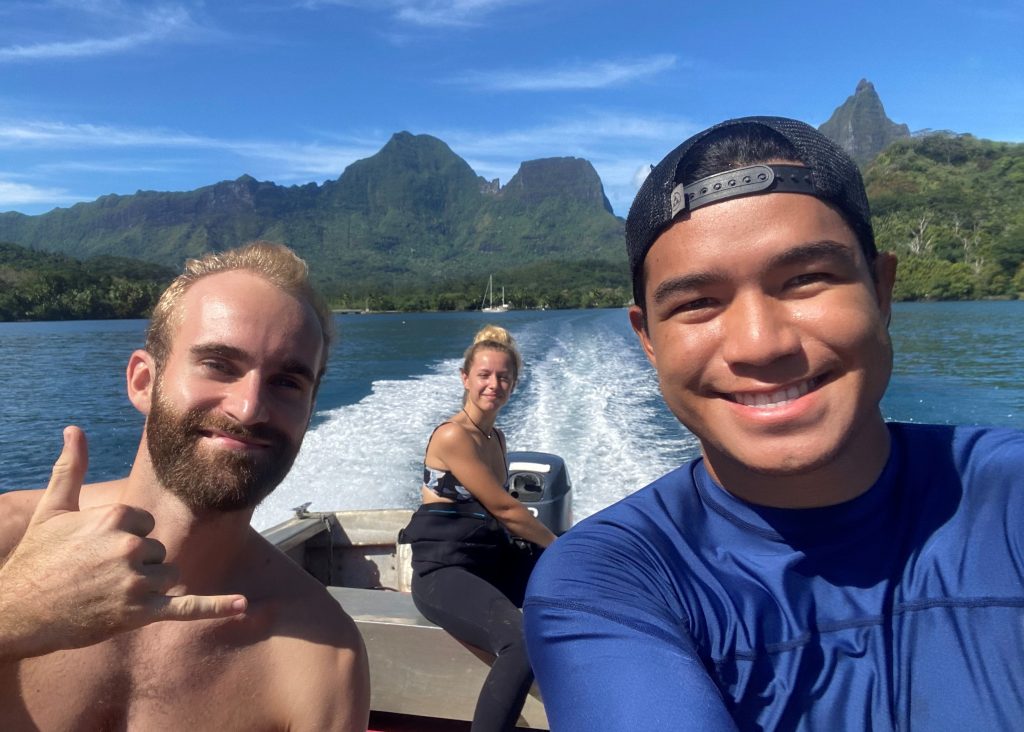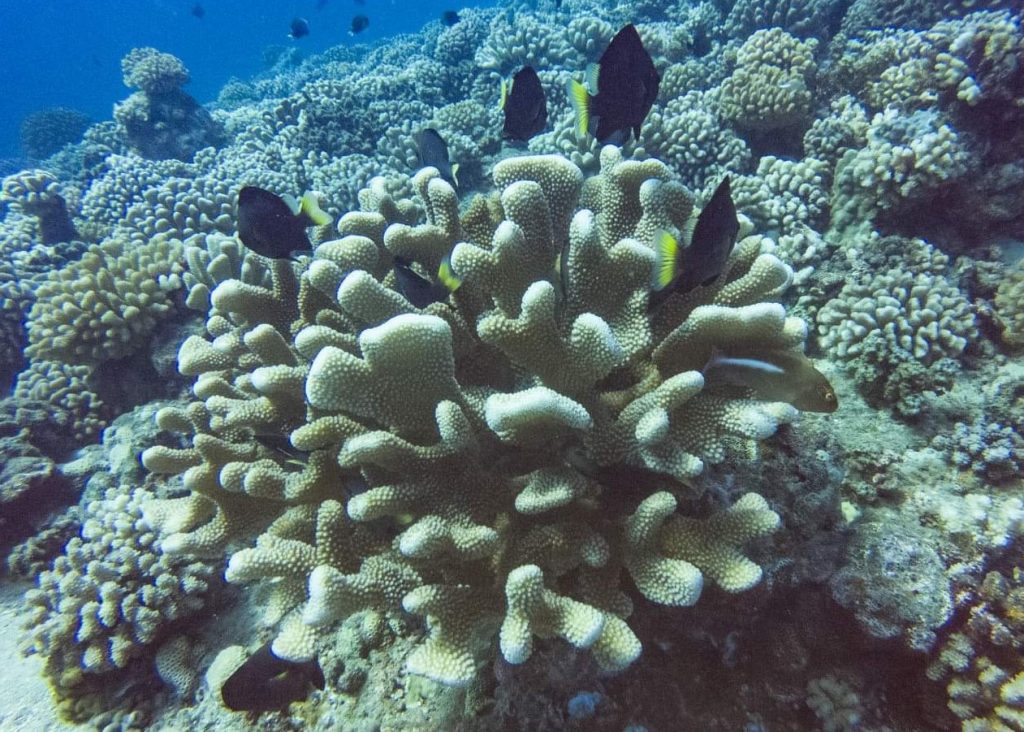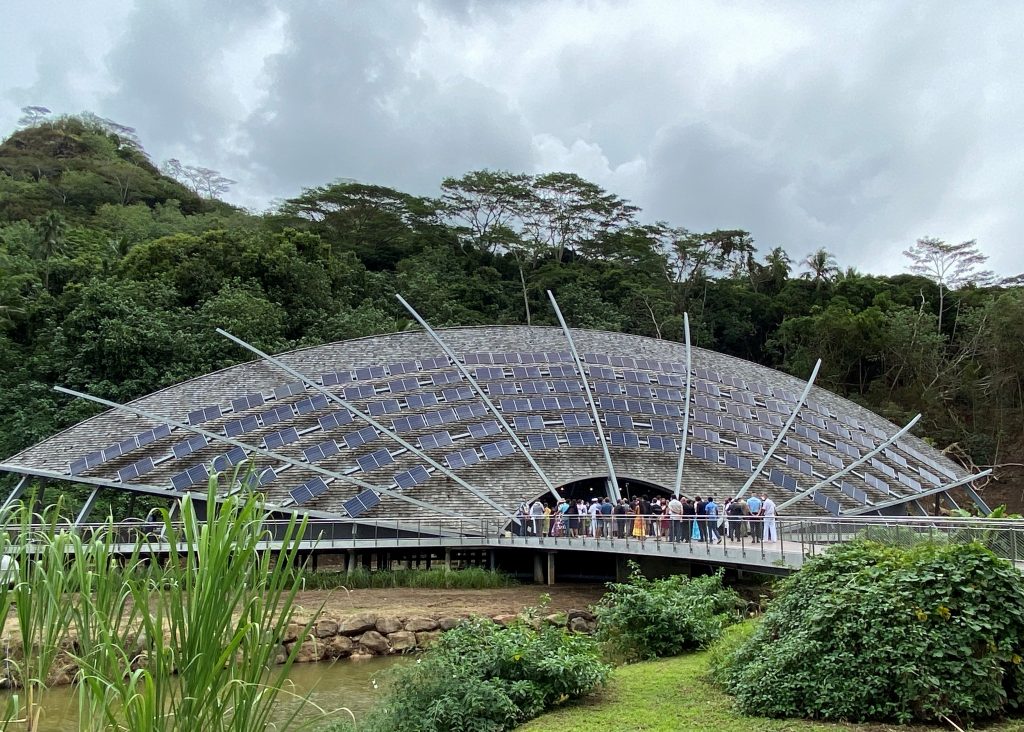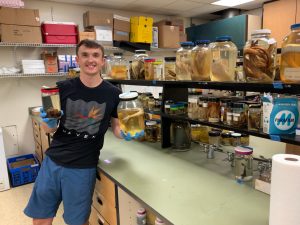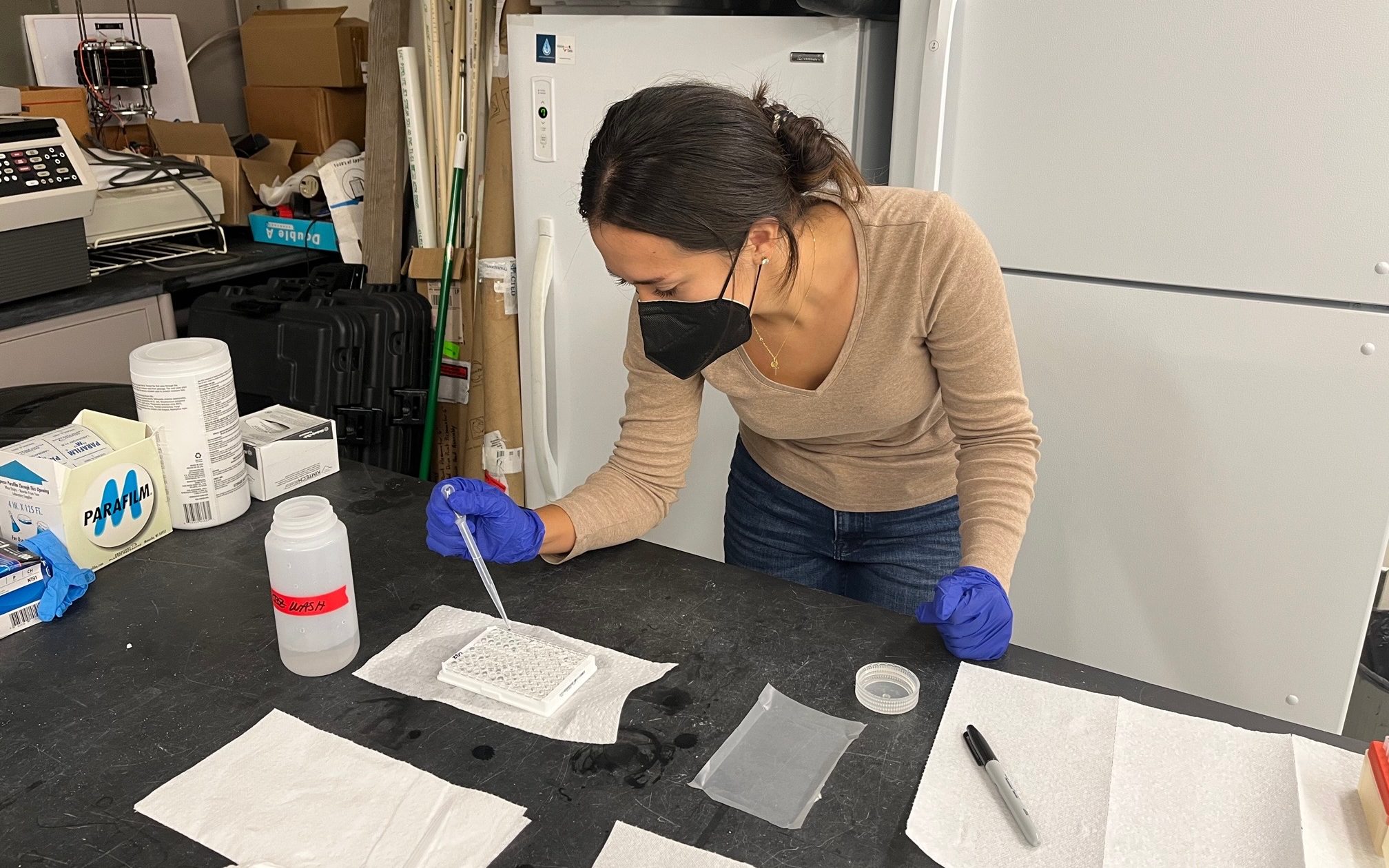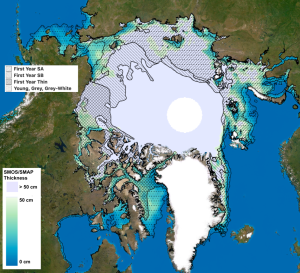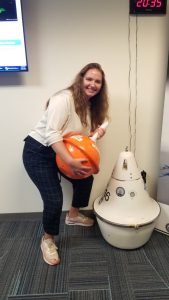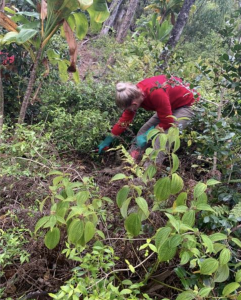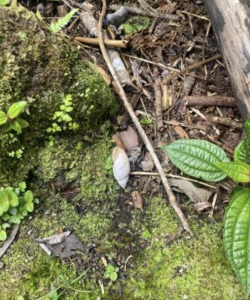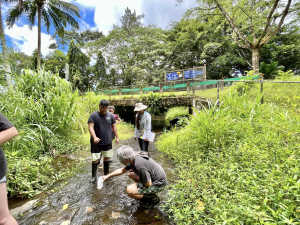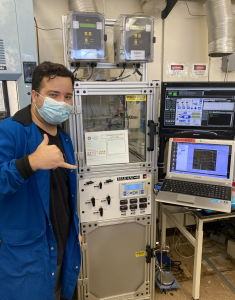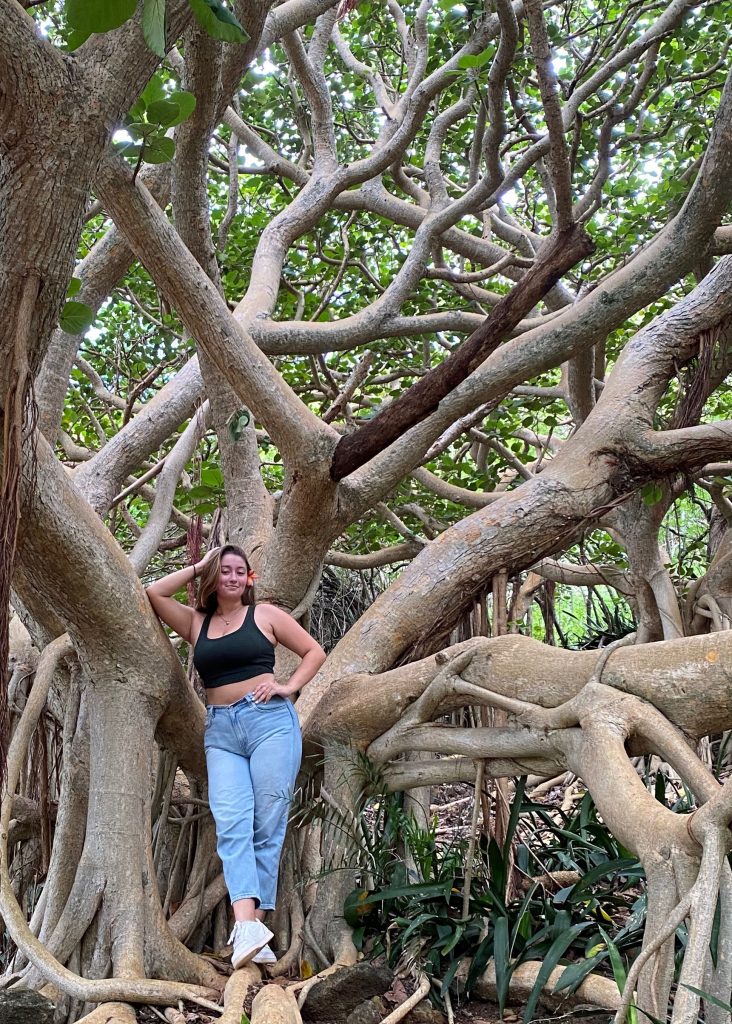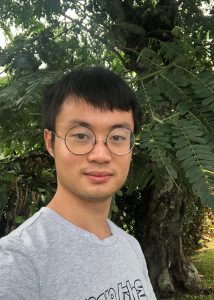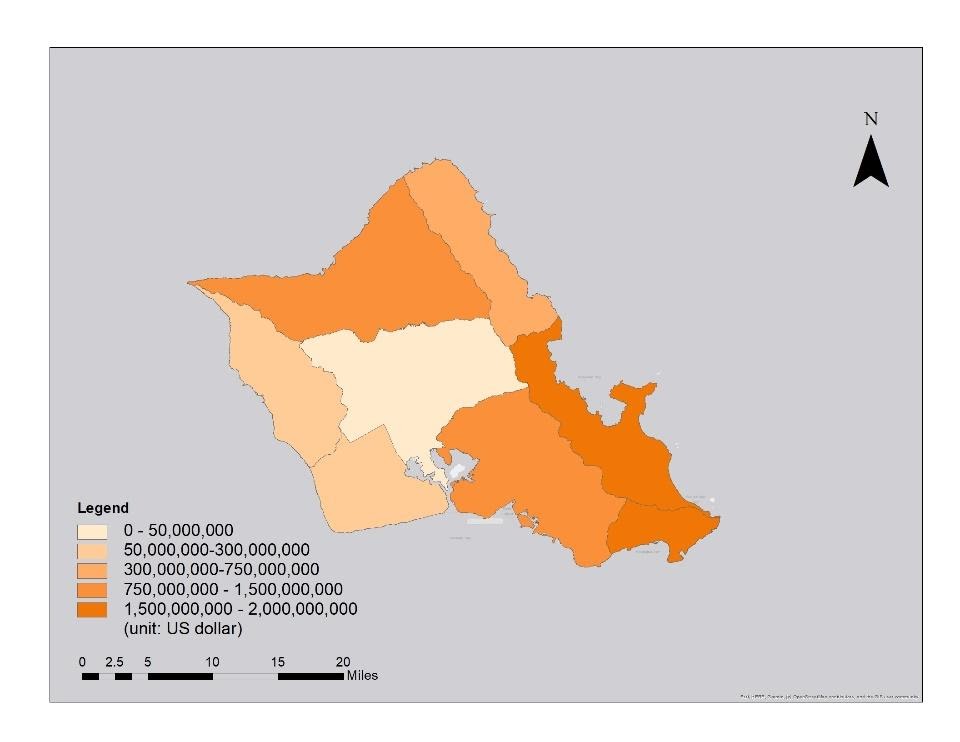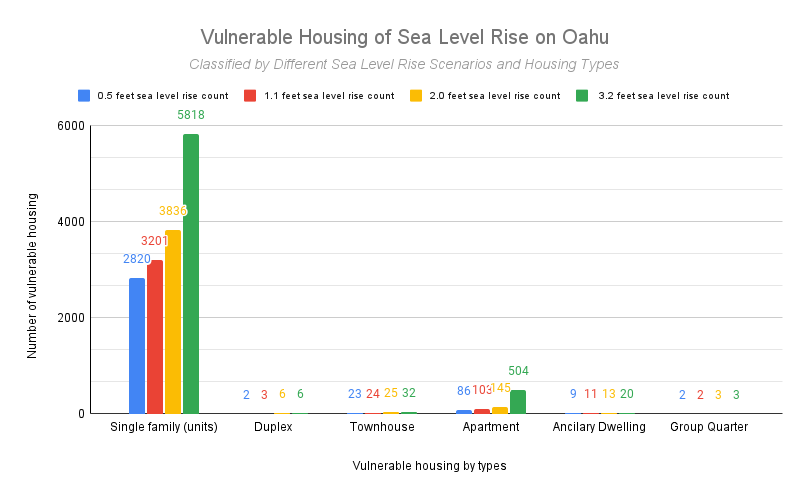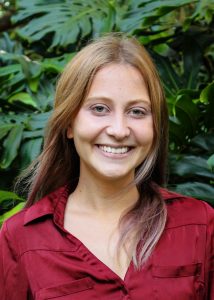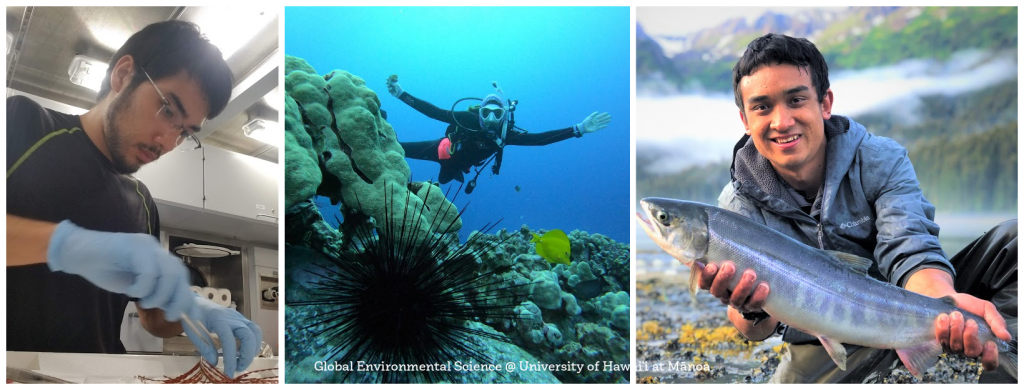
GES Students’ Co-curricular Experiences
Here you can read about current students’ co-curricular experiences such as assisting in research in a faculty lab, participating in cruises, working at internships, and conducting undergraduate thesis research. Click on the tabs below to read each student’s story.
Before entering the Global Environmental Science (GES) program, most of my experience with oceanography centered around coral reefs, specifically studying coral and fish biodiversity and abundance. Growing up in Hawai‘i nurtured my love for the ocean, both recreationally and scientifically, and the GES program provided a broad set of courses that would allow me to engage in many different areas of oceanography while developing a diverse STEM background.
Within the GES program, I became particularly excited to explore opportunities at the intersection of oceanography and computer science. During a GES seminar, I was fascinated by a presentation on environmental modelling given by Dr. Brian Powell, a physical oceanographer in the Department of Oceanography, which focused on using machine learning to understand and forecast ocean ecosystems. This exciting opportunity to use technical computer science skills to solve real oceanographic problems encouraged me to reach out about the work, leading to a position as a research assistant in the Powell lab.
Throughout last semester and this summer I have been assisting on a project through the Pacific Islands Ocean Observing System (PacIOOS) program to produce water quality forecasts for the Ala Wai canal area. The goal of this project is to create a robust model that can predict future streamflow into the Waikīkī area using streamflow and rainfall data from the surrounding Mānoa valley area. Streamflow predictions can then be used as a measure of turbidity, an important indicator of water quality. Going forward, this model will ideally be implemented on the PacIOOS website and be readily available for beachgoers to observe forecasts and avoid turbid days, when bacteria and debris will be highest.
Producing this model involves machine learning, which is a fundamental aspect of the work done in the Powell lab to observe and understand ocean ecosystems. Machine learning is a broad field that involves constraining models using observed behavior described in large amounts of data. Machine learning has various applications within many fields such as predicting scientific processes, analyzing medical scans, or performing image recognition.
The specific approach used in solving the streamflow modelling problem is the construction of a neural network. Neural networks are a subset of machine learning that are structured similarly to the brain, containing layers of neurons that transmit signals. Layers of neurons receive information, process and transform the information, and then send the updated information to the next layer. These layers can be highly complex or relatively simple depending on the nature of the problem. Neural networks are trained over time by comparing the true results to those the network predicts, and then adjusting the network’s internal weights and transformations at each neuron based on those errors.
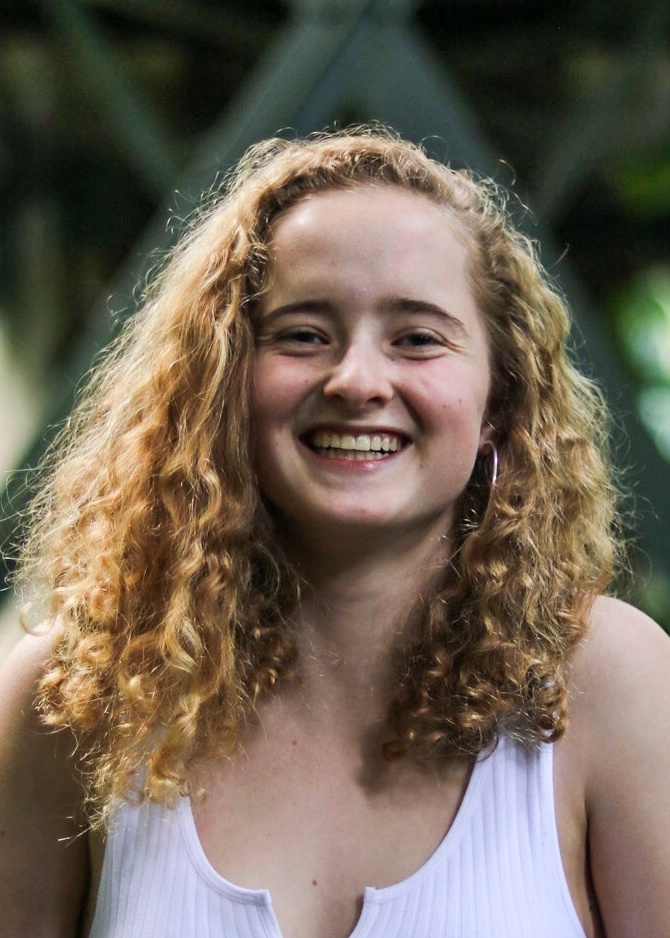
My work involves constructing and optimizing a neural network or model to predict streamflow into the Ala Wai based on past streamflow, past rainfall, and future rainfall. This model was constructed using the programming language Python, which provides various deep learning libraries for creating neural networks. Currently, I am conducting experiments to determine the best configuration for the model to extend streamflow predictions multiple days into the future. This includes determining the optimal number of rain and streamflow inputs for a specific number of streamflow predictions, as well as optimizing the number of neurons and layers of neurons in the network. While this work is still in progress, Dr. Powell and I have gotten some significant results and hope to continue optimizing the model for eventual forecasting use, possibly leading to a focus for my GES thesis project.
This work continues to expand my knowledge of both computer science and ocean processes, and is a real world application of skills gained through the GES program. I am very excited to see where else this work takes me, and am grateful for the opportunity to continue to improve my skills within the field of environmental modelling.
Published September 13, 2021
Over the past weekend I got to participate in an incredible opportunity that both opened my eyes to how a lot of the scientific world works and let me put a lot of the skills I have been learning to good use. I got to volunteer alongside my classmates and faculty members in the Department of Oceanography on the RV Kilo Moana’s Hadal Profiler test research cruise. I had originally heard about the Hadal Profiler from a conversation with Dr. Jeff Drazen last semester and the project was really fascinating to me since I am really interested in deep-sea-biology and was hoping to pursue a research thesis in that area of study. However, this opportunity came to me in my GES 311 class. My professor, Dr. Glenn Carter, was the chief scientist on this cruise and was looking for a group of undergraduate students to volunteer on board. Aside from my initial interest in the Hadal Profiler, what made me apply was the opportunity to use the data collected from the profiler and turn it into a potential research thesis.
When I got the news that I had been selected to participate in the cruise I was really excited, and I hoped I would get the opportunity to help out in any way possible. Naturally, since there were plenty of other undergraduate students on board, I expected that we might not have all gotten to do a lot of hands-on work. I was also really excited to work with everyone since a good few of my friends from GES were going as well. The actual experience turned out to be far more than what I expected in the best way possible. Despite the number of volunteers, we all got to learn and participate in so many different activities and we each had a great deal of responsibilities given to us. I helped assemble the Hadal Profiler and learned how to operate a CTD from the control lab on board. I also learned how to analyze video data collected from the Hadal Profiler.
What I learned about myself throughout this cruise was that this type of work is definitely
something that interests me far past what I had initially thought. Despite the fact that I have been on the Kilo Moana before for HOTs cruises, this opened my eyes to even more perspectives in oceanography and the potential careers that could have come out of it. It feels amazing to see the career I have always wanted since I was a little kid start to play out in front of me through opportunities like this. As for my most memorable experience, it is really tough to say since the whole cruise was just a fascinating and great learning experience. However, the food will always be in the back of my mind as it was some of the best I have had at UH.
Published September 29, 2023.
Last spring, I participated in a study abroad program during which I sailed from the Caribbean to Tahiti, a journey of more than 7,000 nautical miles over the course of 90 days. I went to seven countries, including Dominica, Bonaire, Panama, Ecuador (I went to the Galapagos!), and French Polynesia. Here’s the backstory:
A SEAmester study abroad program was something I intended to do before I committed to the University of Hawaiʻi at Mānoa, or even my major. Sailing tall ships since I was 14, I met a few other people who had done a SEAmester program, all with nothing but positive things to say. SEAmester is accredited through the University of South Florida, but based on the ocean. The organization has three tall ships (a picture of the ship I was on is included for reference), and many different programs to choose from each semester. While old-school sailing to multiple countries, students earn class credits and certifications for sailing and SCUBA. It’s far different from a Semester at Sea cruise ship. SEAmester is much more intimate; there were only 30 other people onboard.
During the 90 days I spent onboard STV Vela, I completed 12 academic credits (four classes). Three of these classes were offered by SEAmester. One was a seamanship course, earning me certifications in navigation, VHF communication and sail handling. I also took marine biology, which will go towards my Marine Option Program certificate. Because we were on the ocean, a large part of our marine biology grade was fish/marine organism identifications. These ranged from seabirds to seagrass. Doing classes and labs in the ocean is something unique that SEAmester was able to offer. One class consisted of snorkeling through a mangrove forest. Lastly, we had a leadership class, which was extremely valuable for working in groups. I will be able to use the skills I gained throughout my academic and professional life. The program also offers introductory oceanography. As a GES major, I had already taken that course my first semester at UH Mānoa. So, my last class was an asynchronous ocean internships class through UH Mānoa that I took for my Marine Option Program skill project (I set up a research project during the fall and wrote the report while abroad).
The classes were fun, but the experiences that stick out to me the most are waking up in the middle of the night for watch changes, seeing stars (like, a lot of them) and using them for navigation, and seeing dolphins outlined by bioluminescence swimming at the bow of the boat one night. The longest amount of time I spent on the water with no land in sight was 23 days. 23 days on a 112-foot-long boat with 30 other people. It might sound like a nightmare to some, but having 23 days with no worries aside from what was happening then and there was very peaceful. Sailing across an ocean required a lot of patience, teamwork and responsibility, but that made it even more rewarding.
I accomplished a lot of bucket list items. I crossed the equator and transited the Panama Canal. I swam in water more than 2000 meters deep, and swung on a vine in the Dominica jungle. I now have friends all over the world, who I’m connected with in ways you can only be when you’ve sailed nearly halfway around the world together, through good times and bad. It was something I could write hundreds of pages about, but I’ll spare you and leave you with this: I might not have gotten to learn a language or deeply explore one country like traditional study abroad programs, but for someone like me it was exactly the experience I wanted.
Published September 7, 2023.
The ocean compels me, both physically and academically. Having grown up between Oʻahu, HI, and Vancouver Island, Canada, most of my memories are intertwined with the ebb and flow of the tides. From exploring tidepools to surfing and freediving, the ocean has always been a constant source of inspiration and wonder to me. Therefore, it is no surprise that my career goals involve working closely with the ocean through research and conservation.
When my academic advisor, Dr. Glenn Carter, told me about the opportunity to help test groundbreaking hadalpelagic sampling technology aboard the RV Kilo Moana, I volunteered within a heartbeat. I was eager to lend a hand with small tasks around the vessel, but my experiences onboard were far more rewarding than I had expected.
I arrived with pre-existing experience with CTDs (an instrument that can create vertical profiles of the ocean’s conductivity, temperature, and depth), so the crew of researchers entrusted me to teach my peers and lead the day shift CTD casts. This allowed me to live a handful of realistic days as an oceanographer– my dream job– and I loved every moment. I had the opportunity to coordinate the deployment of instrumentation with marine technicians, and the responsibility of organizing, labeling, and preparing samples for the cast. Additionally, I managed critical communications between the computer and the CTD, which was operating at significant depths. This experience gave me insightful fieldwork exposure, but most importantly, re-assured that I was chasing the right dream.
However, fieldwork was only one aspect of the cruise. The real value was found within the interactions on board. Watching the developmental testing and troubleshooting of the hadal profiler (new instrumentation that is capable of creating vertical profiles of the ocean within marine trenches, reaching depths never plotted before) was beyond motivating. I felt honored to be in the presence of such intelligent researchers. As I plan to attend graduate school for oceanography, networking with potential mentors was vital as I felt they truly took the time to get to know us as students and people. Not only did they provide me with wisdom and advice, but I learned about more potential research cruise opportunities in the future.
When I boarded the RV Kilo Moana, I believed that I was strictly interested in biological oceanography, but I left with the understanding that the physical, chemical, and biological aspects of the ocean’s interacting systems are equally interesting and important. The hands-on research experience, invaluable mentorship, and newfound appreciation for the interdisciplinary nature of ocean sciences have solidified my passion for oceanography. I am beyond grateful for this opportunity to learn, and excited for the future of the hadal profiler.
Published September 29, 2023
I’ve been working at the Deep-Sea Fish Ecology Lab at UH Mānoa for nearly two years, and I have had some of the most exciting experiences I couldn’t get anywhere else. The latest opportunity I had was working aboard the research vessel Kilo Moana to assist with a research project.

My job was to assist one of the graduate students in the lab with his project assessing the island mass effect. Specifically we were evaluating how the island affects zooplankton feeding off the coast of Waiʻanae, Oʻahu. The data collection process entailed using a large ring net with a container on the end to catch zooplankton. For the best results, the opening of the net was about a meter in diameter. Once the net was brought back aboard, we would separate the zooplankton by size and store them for later lab processing.
Along with the zooplankton tows, I was able to witness the deployment and recoveries of a Hadal Profiler, and a CTD (Conductivity, Temperature, and Depth). The profiler is a unique instrument designed to study the water column of the ocean trenches, the deepest places in the world. In addition to collecting data, the CTD also collects water samples at different depths in bottles around the device. The bottles are manually closed through a computer on the ship.
I was extremely excited to assist on the cruise because it meant I was able to fully immerse myself in the field. Going out to sea to do research has been one of my largest dreams since I started college. I was eager to learn the processes, adapt to the constantly changing environment, and experience groundbreaking science. I was told early on that plans never stay the same, so I was expecting a few small hiccups. However, I didn’t expect major changes such as a full day delay or staying an extra day due to hadal profiler malfunctions.
My most memorable experiences on the ship were the late nights processing zooplankton and bonding with my lab mates. Aboard the ship I quickly fell in love with the constant busy environment with something always going on. Ever since I was little, I always wondered about the sea and loved going out onto boats. Coming from Colorado, this was not something I got to experience very often, so whenever I got the chance, I made sure to make the most out of it. Throughout this cruise, I realized this is what I want to do. I want to be immersed in the field, collecting data, and helping others. This was truly an eye-opening experience that I wouldn’t trade for the world.
Published September 29, 2023.
Engineering was the only pathway that I have known since middle school. In seventh grade, I
joined the robotics team as a programmer, and in high school, I joined the robotics team as a
website manager and electrical team member. In sophomore year, I became the team captain, which opened doors to more opportunities that my team’s advisor connected me to. I
participated in Arduino boot camps, STEM and engineering summer programs, and spent
countless nights building robots every year. When it came time to pick a major, I thought that it would only be natural for me to choose electrical engineering. Not only did all my friends choose to go into this field, but my mom also encouraged me to be an engineer.
However, as I went through the degree, I realized more and more that I did not want to spend
the rest of my life as an engineer. For years, I went with the flow and thought it would turn out
okay, but now I started to have a mental crisis on what I actually wanted to do. I started
researching different degree programs, taking different classes, and really thinking about what I wanted to do in the future.
During COVID-19, I I started to become interested in how the way we build our cities affect our
health, and also ways to become more sustainable as an individual and as a community. After
researching different degrees available at UH Mānoa, I chose to switch to the GES program. I
felt that this program would be broad enough where I can explore my interests, and I was also interested in doing an undergraduate thesis. Most importantly, I wanted to pursue the Bachelor’s and Master’s Pathway that was available through the program. I decided to apply for the BAM with the Master’s of Public Health in Epidemiology as I am also interested in disease formation and prevention, and wanted to be in this career field without making a drastic switch in my undergraduate studies.
While looking for possible research topics, I met up with my current advisor, Dr. Kimberly
Burnett, from the University of Hawai’i Economic Research Organization (UHERO). She
connected me to Sumida Farm, a local watercress farm, and suggested that I do my research
on the benefits of local agriculture using Sumida Farm as a case study. I decided to pursue this research topic as at the time, I was very interested in Hawaiʻi’s sustainability plans to become a sustainable city by 2050. One of these goals involves doubling local food production, as Hawaiʻi currently imports 90% of its food and products into the state. I was curious how much of an economic and environmental impact local produce made, and if the benefits outweigh the cons of importing produce.
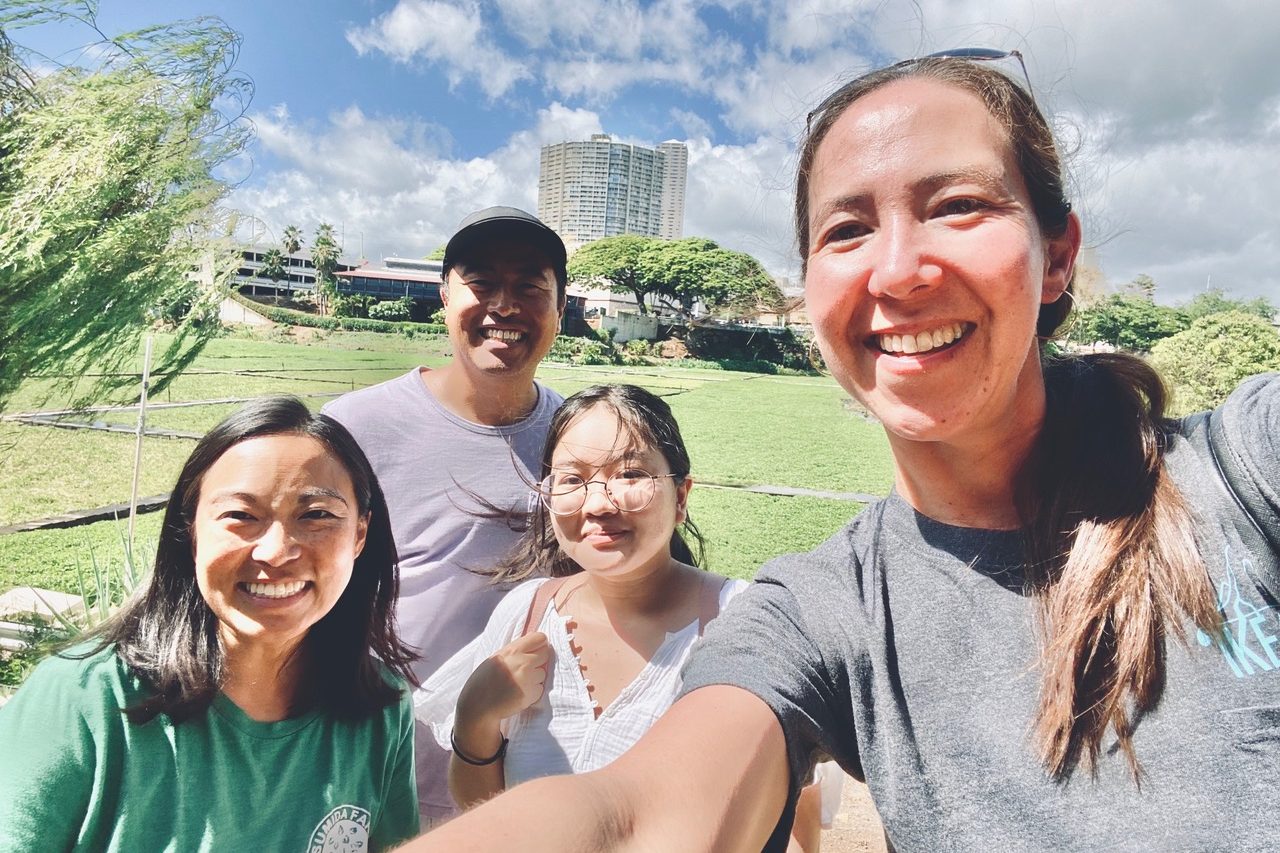
Being in the GES program opened the doors for many different opportunities that I am grateful for, and allowed me to explore my true interests that I couldn’t do in engineering. Academically, GES has taught me to become more appreciative of our environment, and how I can give back to the community and the environment. Overall, I am happy I took the leap to change degrees, and my only regret is that I didn’t switch earlier.
Published on September 7, 2023.
Growing up on the water in Kāneʻohe Bay, I was always interested in the ocean that surrounded me. In eighth grade, I witnessed the impact of the 2014-2015 massive coral bleaching events on the reefs in our bay, and I chose to do my science fair project tracking coral recovery after bleaching. As a result of this project, I was fortunate that my teacher, Mrs. Tina Chan at King Intermediate, connected me with the education department at the Hawaii Institute of Marine Biology (HIMB) located at Moku o Loʻe, otherwise known as Coconut Island.
As a freshman in high school, I was able to participate in two marine science programs at HIMB that helped solidify my interest in marine science and connected me with several important mentors. The Kulia Marine Science Club met after school once a week during the school year. Mike Henley, a graduate student at the time working in the Smithsonian Institution’s Hagedorn Lab, provided club members with hands-on opportunities to learn about marine science research methods and guided students as they presented research projects at the annual Imi Wai Ola Student Science Conference. The Research Experiences in Marine Science, or REMS program, was an intensive summer program that introduced high school students to different fields in marine science. Directed by Dr. Malia Rivera, a University of Hawai‘i at Mānoa (UHM) faculty member and the director of the HIMB Science Inquiry Education Program, REMS allowed students to focus on a hypothesis-driven research project while also earning college credit.
These exciting experiences inspired me to conduct my own independent marine science projects and compete in science fair my Sophomore, Junior, and Senior years of high school. All three years, I was able to explore different aspects of coral ecology and restoration. My participation in the marine science club and science fair lead to Mike offering me an internship to work with him on his doctoral dissertation work.
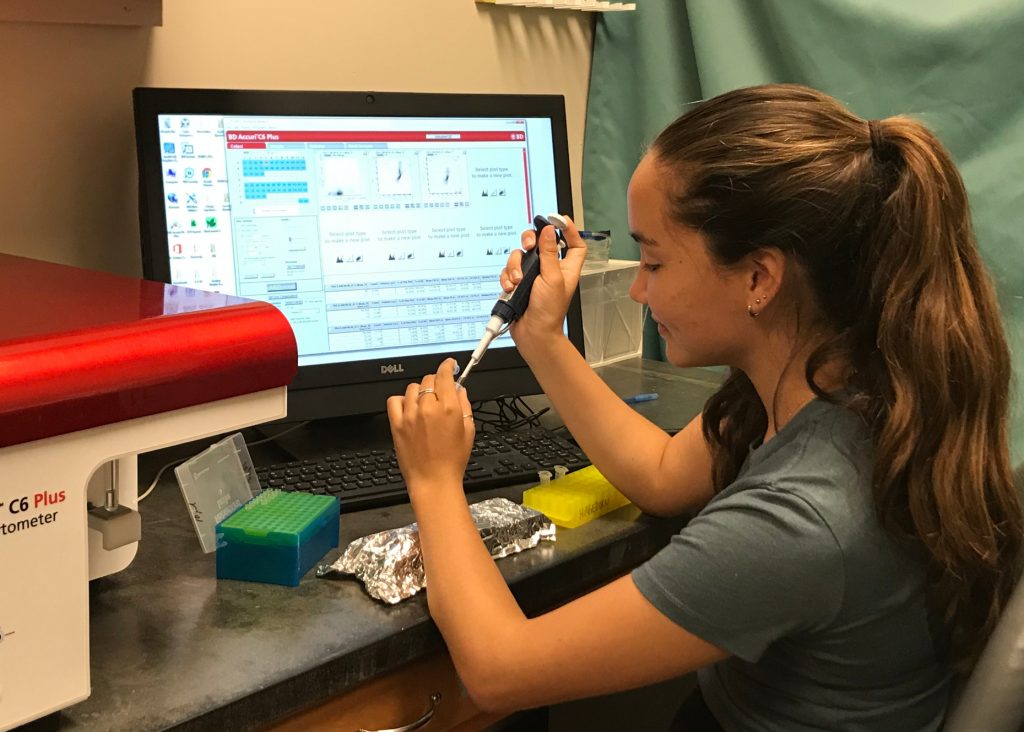
I began working with Mike the summer of 2018, after my sophomore year, and continued working for the lab in 2019 where I helped Mike investigate the reproductive differences and patterns between two corals found in the bay, Montipora capitata and Montipora flabellata. Following the bleaching events that I witnessed first-hand just a few years prior, we sought to understand why some corals can survive bleaching events more effectively. For two consecutive summers we spent long hours documenting the spawning patterns of the two species and examining their reproductive behavior, gamete quality, and fertilization capability. From May through August of 2018 and 2019, we worked most nights, starting at about 7 pm to catch the corals spawning starting at about 8 or 9 pm. If the corals did spawn, we would then work several more hours into the night to process the specimens. These hours were quite long and, at first quite difficult to adjust to, but the research was exciting and fun and worth the hard work.
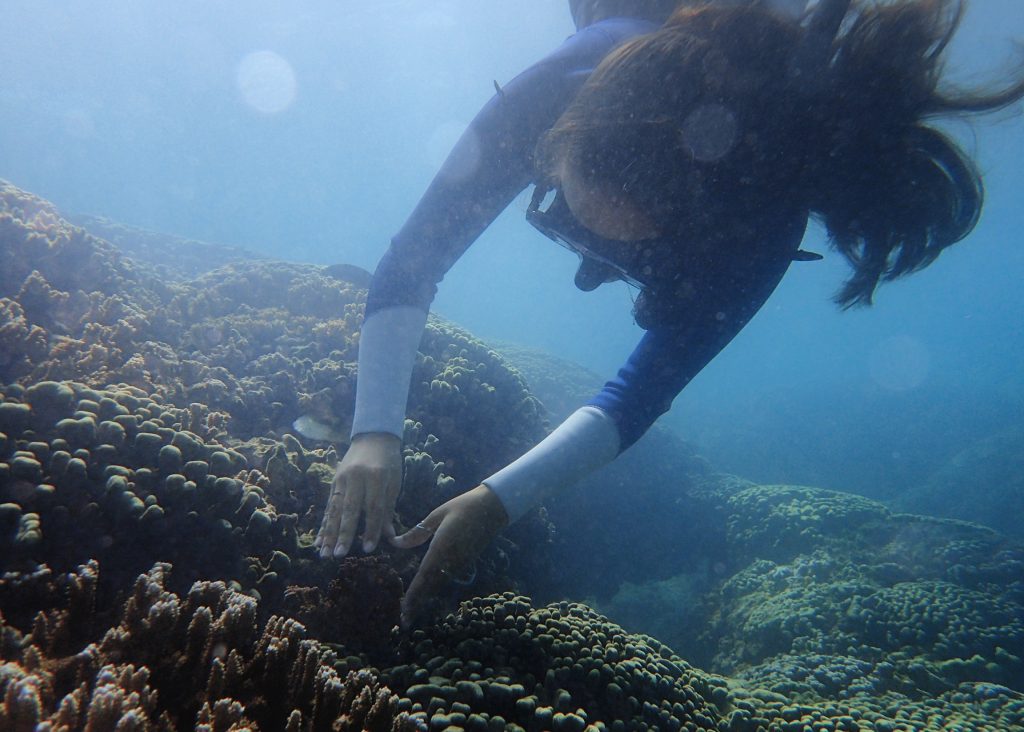
During both summers while I was working with Mike, I also participated in different REMS programs at HIMB. In 2018, I was a REMS mentor for new students. Later I participated as a student in the inaugural REMS XL cohort, which challenged students to explore more in-depth independent research projects. Immersing myself in these different experiences of working with Mike and participating in REMS largely shaped my goals for college. I gained a deep understanding and appreciation about the importance of collaboration and communication in research from working with fellow students in REMS and gained valuable lab and field skills as a researcher working with Mike and the Hagedorn lab.
These experiences, and the mentorship I received from Mike and Dr. Rivera, led me to apply to the UHM Global Environmental Science (GES) program. The GES program allows me to build strong relationships with my peers and professors and makes it possible to for me to continue working at HIMB. I am currently working with Dr. Jess Bouwmeester from the Hagedorn to explore the cryopreservation of coral symbionts, as well as with Dr. Rivera to investigate the use to sea urchins as a biological indicator of water quality.
Read the article on Montipora corals that Mariko co-wrote here.
Published September 10, 2021
In my sophomore year of college, I had the opportunity to go onboard a Hawaiian Ocean Time Series (HOT) research cruise. At the time, I had little to no experience with oceanography and how vast the aspects of research were. Throughout the cruise, I learned about different researchers’ projects and interests, methods of at-sea sampling and testing, and the significant contributions these projects have to ocean research.
Following the HOT cruise, I realized I wanted to learn more about the different areas of ocean research and find ways to write my undergraduate thesis on it. It was through my interest in these research cruises that I was connected with Dr. Angelicque White and Dr. Fernanda Henderikx-Freitas at C-MORE Hale and their work with the IFCB.

The IFCB, or Imaging FlowCytobot, has the capability of continually capturing microscopic images of particles and their fluorescence for months at a time. It is used onboard research cruises such as the HOT cruises to document a variety of taxa and track various algal blooms, quickly becoming a major contributor to our knowledge of plankton dynamics. For my thesis, I have been looking at IFCB images from two research cruises, PARAGON 1 and 2. PARAGON 1 took place in the summer of 2021 towards the end of a bloom event while PARAGON 2 took place in the summer of 2022 and in the middle of a bloom. Between the two cruises, the IFCB captured images of roughly one million taxa and detrital material. Along with this, each image was documented with the particle’s diameter and fluorescence through the help of video and flow cytometric technology.

In order to better visualise and note trends in the taxa from these bloom events, each image ideally down to the genus level. However, the current training sets for automated classifications are still in the development process, making manual annotations a vital part of the process. Alongside a team at White Labs, I am currently working on manually sorting IFCB images from research cruises such as PARAGON and HOT, aiming to develop better training sets that can increase the algorithm’s classification success rate.

Using the IFCB data from the PARAGONs, my thesis looks into the trends seen in the algal blooms within the North Pacific Subtropical Gyre (NPSG). Through classifying the taxa from these blooms events, I can begin to analyze the abundance of particular taxa over time, their seasonal patterns, and contribute to a better understanding of an algal bloom’s life cycle.
Published September 27, 2023
During the Summer of 2023, I had the opportunity to work for Dr. Andrea Jani–a professor and assistant researcher in the Department of Oceanography at the University of Hawaiʻi at Mānoa. At the end of the Spring 2023 semester, Dr. Jani was looking for an undergraduate assistant for the summer break. I had emailed her expressing my interest in the position as I had taken her “Disease Ecology” course that spring (OCN 340 for those who may be interested in taking it) and was familiar with her as a professor. In addition, having gained experience in microbial research with my current principal investigator, Craig Nelson, I had a strong interest in working with Dr. Jani as she also studies microbiology.
In particular, Dr. Jani is studying the microbiomes of Hawaiian Drosophila (small fruit flies). She is interested in identifying pathogenic species of bacteria from the Drosophila gut microbiome and is currently focusing on two species: Drosophila crucigera and Drosophila grimshawi. Initially, I was brought on to rear the Drosophila for her research and conduct essential laboratory work. However, those initial tasks quickly grew into a wide variety of responsibilities. Rather than just working on rearing the Drosophila, I began to work on all aspects of the project. I learned how to extract the DNA from the Drosophila, conduct PCR, culture bacteria in various media, and began to run the Drosophila experiments from beginning to end.
While the position initially started as a summer-only employment, Dr. Jani extended the offer and I was able to continue working for her in joint with my employment at the Nelson Lab. Being able to work in Dr. Jani’s lab has been a wonderful opportunity for me. Not only has it allowed me to explore another field of research but I have also learned critical laboratory skills that I was not able to learn within a classroom setting. I am constantly looking for ways to diversify my skill set and research other fields as my research interests are always growing and changing–I have yet to find a topic that has not captured my attention. I am excited to continue working for Dr. Jani into the academic school year and hope to learn more about her work and research.
Published September 7, 2023.
During the Summer of 2022, I was a pilot participant in a Research Experiences for Undergraduates (REU) internship at the Hawaiʻi Institute of Marine Biology (HIMB) under Dr. Keisha Bahr in a joint program through the University of Hawaiʻi at Mānoa and Texas A&M University. I had only just gotten my feet wet in the field of oceanography and marine biology (pun intended), but still had a significant interest in corals and ocean acidification after taking a course in oceanography the previous year. I was interested in participating in an internship over the summer, as I had no prior experience in the field or doing anything remotely related to actual scientific research due to COVID-19. Luckily, in a weekly newsletter sent by SOEST Student Academic Services, I was able to find and apply for the REU internship which happened to be focused on the exact interests I had in mind.
The internship took place at the Point Lab at HIMB and was centered around the Proton Flux Hypothesis Experiment–an ongoing study on ocean acidification and corals. The Point Lab is particularly special as the Proton Flux Hypothesis Experiment utilizes 12 flow-through tanks connected directly to Kāneʻohe Bay. The seawater is modified before flowing into the tanks to create ocean acidification conditions in order to analyze the effects on two corals: Montipora capitata and Pocillopora acuta. This setup is as close to in situ as one could get, creating a very realistic environment for the experiment to take place.
Throughout the internship, I took daily measurements for the experiment conducted by my principal investigators (PI) while simultaneously performing an independent experiment with my peer interns. In the independent project my peers and I ran, we tested whether corals from different environments on HIMB would react differently to varied ocean acidification conditions. We took data on numerous parameters on Montipora capitata–our selected coral species–and collected data on calcification rates, photosynthetic rates, and seawater chemistry using tools such as titrators, PAM, YSI, and more. I am currently working on analyzing the data with my intern peers that we collected over the course of the experiment in hopes of turning our work into a manuscript for publication.
In addition to the manuscript I am working on for the REU internship, I am currently working at the Nelson Lab at UH Mānoa, analyzing the microbial communities of the Proton Flux Hypothesis Experiment corals to see whether there will be differences between the varied ocean acidification conditions. Dr. Craig Nelson had an opening in his lab at the start of the Fall semester, and while I initially joined his lab to work on running fluorescent samples for his numerous projects, his connections to my internship PIs led me to a potential thesis project that combines both aspects from my internship as well as the lab I am currently working in. While the project is currently underway, I hope to see it form into a thesis that I can present in my senior year as well as a source of additional research and data for my PIs at the REU internship.
Published December 20, 2022
I am Peter Felicijan, a Junior undergrad at UH Mānoa working as an Oceanographic Technician
Assistance in Dr. McManus’s Lab for the PacIOOS Near Shore Team. I selected the University
of Hawai’i at Mānoa because of the prestigious and rigorous Global Environment Science
program. I have always been concerned with global environmental issues and want to learn how to think critically about topics like sustainability, climate change, environmental pollution, and loss of biodiversity. Coming to UH Mānoa and immersing myself in the GES program has been a welcoming challenge on how to address these issues.
My undergrad thesis project that I am currently working on, along with my GES mentor Dr. Margaret McManus (Professor, Department Chair, and Graduate Chair for the Department of Oceanography at UH Mānoa) is for the Hawai’i Department of Health/Clean Water Branch. The project is the deployment of three CTD sensors in Ke’ehi Lagoon. The PacIOOS Near Shore Team constructed three moorings each with its own CTD sensor. The sensors were placed in various locations throughout the lagoon to survey the quality of the water throughout the seasons as it changes with environmental forcings (i.e., wind, tide, storm events etc.). With the data we retrieve I acquired the skills to form Matlab graphs to see the changes in pressure, temperature, conductivity, chlorophyll, turbidity, and salinity throughout the seasons. Through historical researching of past seasonal data e.g., monthly rainfall, air temperature, tidal changes, and wind direction, I can determine how these forcings correlate to changes in the water characteristics.
My goals are to graduate in the Spring of 2024 and continue my education with a master’s and eventually a PhD in Oceanography. The reasons I selected Oceanography to be the focus of my future educational goals are based on the experiences and passions I have developed from being a part of the programs and extracurricular activities I am in. The GES program, through the research classes I have taken, has shown me the devastating impacts on marine organisms due to human interactions. Working with PacIOOS I gained firsthand experience of environmental destruction, such as pollution, on the coast of Oʻahu. Constantly being immersed in oceanography through a variety of ways I have been developing a passion to assist marine life through research and solutions. I wish to continue working for a research institute such as NOAA, PacIOOS, Oceana, Coral Reef Alliance, etc. This would set me on the path to continue following my passion.
Published August 15, 2022
My name is Stephanie and I am a nontraditional student from Hollywood, CA. Growing up in the heart of Los Angeles was fun, but students like myself were easily overlooked. As many kids are, I was curious and always asked questions. Luckily, I had someone in my life that fed that curiosity who took me to museums, watched documentaries and explored the little bit of nature we have available. I never felt smart enough to consider a career in science, but once I came across oceanography and marine biology on accident, I knew this is what I wanted to do. The issue was that I did not have the math and science background, so I wasn’t sure this was for me. As an adult that graduated high school a long time ago, it felt challenging and overwhelming to go back to school and pursue a career in science.
I attended Santa Monica College where I was in the STEM program, and while I was there during the summer of 2019, I did my first internship at USC where I lived on Catalina island and worked on a project trying to keep phytoplankton alive and have them bloom as well. While working there, I met Dr. Nick Hawco who was also working in that lab and in our conversation, we realized we were both transferring to UH Mānoa. Originally, I transferred as a Marine Biologist since that was the only major available at the school I transferred from, but I decided to switch my major to GES because I want to pursue a career in Oceanography and conduct research and I was advised this is the closest major to it. I have to add that when I first transferred it was challenging in many ways because I moved during the pandemic, so I didn’t get to meet anyone or go on campus for almost a year. During my first semester at UH Mānoa I took OCN 201 and Nick was one of the instructors, so I decided to reach out to him and now I am finalizing the thesis I have been working on in his lab. My thesis work is based on Cobalt concentration in the ocean and how they differ regionally. I ran samples that were collected from 2016 to 2018 during the TARA Ocean Cruise. I am also investigating if there is any correlation between Co and phytoplankton concentration.
Now that I am almost done with school and having lived some good and not so good experiences living out here, there has always been one consistent thing and that is my hunger for knowledge. I feel that being a part of GES and the way the program is structured really prepares us for the workforce or to go on to graduate school. I hope to move forward in my academic career and be a part of the solution for a healthier planet.
Published September 7, 2023
This summer, I am fortunate enough to have been accepted into a position as an intern with Mālama Learning Center’s (MLC) Ola Nā Kini program. Founded in 2004, MLC is a non-profit organization that seeks to bring together conservation, culture, and environmental education for the ecosystems and communities of West O’ahu. Through programs that are grounded in place-based, hands-on learning, the organization seeks to promote sustainability statewide and inspire communities to create healthy environments. My job as an Ola Nā Kini intern is to work with the MLC field crew, which takes care of the many conservation and reforestation areas managed by the organization. These sites range from the Nānākuli coastline to the mountains above Kapolei and they double as outdoor classrooms for the student groups that MLC works with.
An average day with the field crew starts at MLC’s Pālehua or Kapolei nursery, where we open with a team meeting and discuss plans for the day. The nurseries are where all the native plants used in reforestation projects are grown and we generally spend a few hours a week doing the weeding, watering, and repotting necessary to care for them. The rest of our time is generally spent at one of the sites managed by the organization. Field crew duties vary based on the site, but we largely focus on invasive species removal, erosion control, seed and cutting collection, and fire prevention. Wildfires are notoriously common in some of the areas where we work, so removing dry brush and grass is always high on our list of priorities. The work we do can be hot and physically challenging, but it is always tremendously rewarding to clear out a patch of potential tinder or uncover a native plant that was being choked out by invasives.
Another important responsibility of the field crew is to teach and work with the volunteers who come to visit MLC’s various sites. These vary widely, from school kids in summer programs to groups of coworkers from local businesses. Some have careers in conservation while others have never picked up a shovel in their lives. No matter the group, having additional pairs of hands is always welcome and it allows us to accomplish far more than we could normally.
My time with Mālama Learning Center has been incredibly meaningful and enjoyable, and from it I have learned a great deal about the significance of conservation. Conservation is important for both the sake of local ecosystems and because it is deeply intertwined with other environmental issues. Deforestation in Hawai’i can often lead to severe soil erosion, which can be seriously detrimental to downstream habitats such as coral reefs. The dry, invasive-dominated forests of West O’ahu make places like Nānākuli and Wai’anae some of the most fire prone regions in the country, causing air pollution, further erosion, and risk to human populations. Globally, the world’s forests are the largest carbon sink that humans exert any meaningful degree of control over and deforestation is responsible for a significant percentage of anthropogenic greenhouse gas emissions. It is my hope that more people can learn about the ecosystems that surround them and what they can do to care for them. Millions of years of evolution have gone into shaping our natural world, but its fate is in our hands.
Published July 22, 2021.
My name is Keanu Rochette-Yu Tsuen and I am from Tahiti, French Polynesia. I am a junior student in the Global Environment Science (GES) program. I transferred to UH Mānoa from Kapiʻolani Community College where I had the opportunity to do multiple research projects in botany/ethnobotany, ecology, and microbiology. These opportunities got me more interested in research, hence my decision to major in GES.
Due to COVID-19, I got caught in a lockdown in French Polynesia during summer 2021, and I took this opportunity to apply for an internship at home. I contacted faculty members at the Centre de Recherche Insulaire et Observatoire de l’Environnement (CRIOBE), a French research center located on the island of Mo’orea, in hopes to work on a reef conservation project. My research topic was on surveying reefs and assessing the changes in coral cover on Mo’orea and throughout the different archipelagoes of the country over the years. During the month of July, I was trained on coral taxonomy, i.e., how to recognize different coral genera and species, as well as different survey techniques which include quadrat/transect surveys, image processing and photo analysis.
Throughout my internship, I learned about the great diversity of corals that could be found in French Polynesia and characteristic traits that can make coral taxonomy challenging. Certain corals can be difficult to differentiate on site and must be observed through binoculars to determine their exact species (e.g., Porites species). I also learned about the current ecological changes that threaten our coral reefs, related to climate change, local pollution, predation, and natural disasters. This internship experience was invaluable, personally, because I was able to do tangible marine research in my country as an undergraduate, which is not commonplace.
Interning in Mo’orea reinforced my determination to work in preserving those coastal ecosystems and marine resources to better protect the communities that rely on them. Other than research, I was also able to partake in two major events this summer. We celebrated the grand opening of a natural science museum, Te Fare Natura. The CRIOBE founded this museum in order to translate their research and make the information accessible to the community. In addition to this event, French president Emmanuel Macron visited the research center during his presidential journey in the French overseas collectivities.
Published September 15, 2021
Growing up I felt I had some grasp of the biotic diversity on Earth. My whole world changed during my research experience in a deep sea laboratory. Studying the deep sea opened my eyes to the nearly countless population of understudied species. Realizing that just a small fraction of eukaryotic species have ever been described, I began to question the completeness of attempts to assess the effects of the anthropocene on biodiversity. To develop the best tools possible to assist in solving this problem, I added a biology minor to my GES track.
My work in the deep sea sparked my interest to document species and promote biodiversity. I later joined separate UH research on effective restoration of ‘iliahi (Hawaiian Sandalwood), an endemic Hawaiian tree. ‘Iliahi is hemiparasitic and connects to hosts to exchange nutrients. This research will culminate in several published papers. One paper will use stable isotope tracers to detect the type of symbiotic relationship, and another will discuss outplanting ‘iliahi with potential hosts to study host suitability. During my ‘iliahi research, I discovered my calling for forest restoration. Forest restoration is important, among other reasons, to fix carbon and restore ecosystems. I firmly believe, however, that a species is worthy of conservation and restoration even if it offers no apparent benefit to humans.
A series of opportunities, including my research project that uses genetic evidence to detect
cryptic species in the South American fruit fly, has deepened my understanding of genetics as a tool for conservation. My thesis research is the culmination of my passion for conservation with my emerging genetics skillset. That research uses advanced genetic methods to determine the provenance and conservation needs of an extralimital population of lizards.
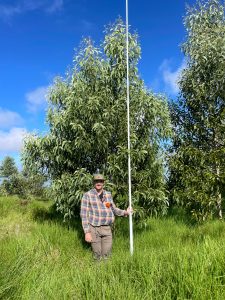
Until recently, the topics I find captivating remained more of a fascinating pathwork of discrete topics than an interconnected fabric. Then it clicked; fungi can be the nexus. Fungi are historically understudied and under-described even though fungal networks are indispensable for a healthy forest ecosystem and form complex symbionce with trees. I plan to use genetics to document unknown species of fungi, reveal their evolutionary relationships, and describe their symbionce with plants to inform forest restoration.
Importantly, this work is not intended to claim that we discovered a species. Species have
intrinsic value, and it is deeply anthropocentric to suggest we can “discover” something that has existed for millenia. Rather, work like this should aim for a humble understanding of the planet’s sophisticated processes and the effects of climate change. I hope that my work will promote a deeper understanding of the symbionce between trees and fungi. We can better inform conservation and restoration efforts if we have a more granular knowledge of the species that need help.
This summer I worked on my thesis research, assisted with ‘iliahi fieldwork on the Big Island,
and was a TA for a cellular and molecular biology class. I am also in the process of applying to
PhD programs in fungal systematics and evolution.
Published August 16, 2022.
My name is Caleb Mantanoña, a senior at the University of Hawaiʻi at Mānoa set to graduate Spring 2023. I have always had a passion for environmental stewardship and sustainability, so joining the Global Environmental Science (GES) program that allowed for a rigorous and student-tailored curriculum was an easy decision. I originally joined the GES program in Fall 2019 with the expectation to build a career toward conservation and natural resource management; however, through my interactions with the diverse students, professors, and professionals in the SOEST network, I was exposed to the seemingly endless career pathways I could take and decided to explore every avenue I could. Luckily, the flexibility of the GES program allowed me to discover specialties that piqued my interest and I am appreciative of the support that the program has given me throughout my chaotic undergraduate journey.
Spring and Summer 2022 brought unique opportunities for me to continue discovering new fields of study. I was fortunate enough to be accepted in the NIH-funded Minority Health Research Training (MHRT) 2022 cohort, where I delved into my interest in health and medicine for 6 months. The MHRT program provided in-depth instruction on minority health research in both lab and public health contexts, as well as professional development. This all came together during the summer session when I completed my mentored research project that analyzed historical air quality data on the Leeward side of the island of O’ahu in order to describe how wildfires impact air quality, specifically particulate matter patterns.
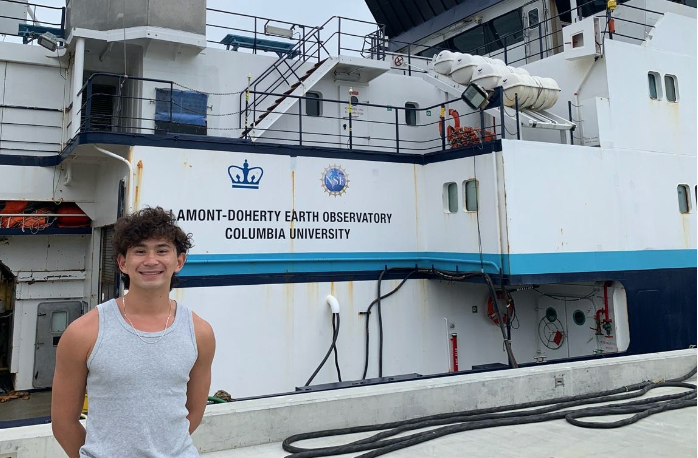
Simultaneously, during this MHRT experience, I was also invited to be a part of a student training program through STEM-SEAS, a Columbia University funded program that gives minority students opportunities to gain hands-on learning on research cruises. I spent two weeks contributing to various research projects and gaining invaluable knowledge from the inspiring program leaders. The immersive learning environment was something I greatly needed after working remotely due to the COVID-19 pandemic.
One of the major takeaways the past year has taught me is that I want to continue seeking new experiences. Both the MHRT and STEM-SEAS programs were opportunities that came suddenly and made me fearful of failure because of my lack of experience. I had to remind myself that I am exactly where I need to be and that I will fully embrace the present moment. By this mindset, I was able to learn so much about these fields of study and even more about myself.
As I finish my senior year, I am continuing working with my MHRT mentor, Dr. Saksena from the East-West Center, where we are calculating the emissions from large wildfires in Hawai’i. Like my past experiences, where I chose to do something that is new and intimidating, jumping in headfirst and embracing the challenges will lead to the growth I want for myself.
Published December 6, 2022.
During my time in the GES program, I have learned a lot about myself, my role in
science, and in my own community. I entered the GES program after graduating from
Kamehameha Schools in 2019, not knowing much other than that I was interested in
environmental issues, helping my community, and reconnecting to Hawaiian language and
culture. In many ways, some of the issues that impact the local and Native Hawaiian
communities in Hawaiʻi are closely tied to environment and ʻāina, and although I perhaps sensed these connections at the beginning of my time in GES, I would come to reflect upon and better understand this issues in the next four years.
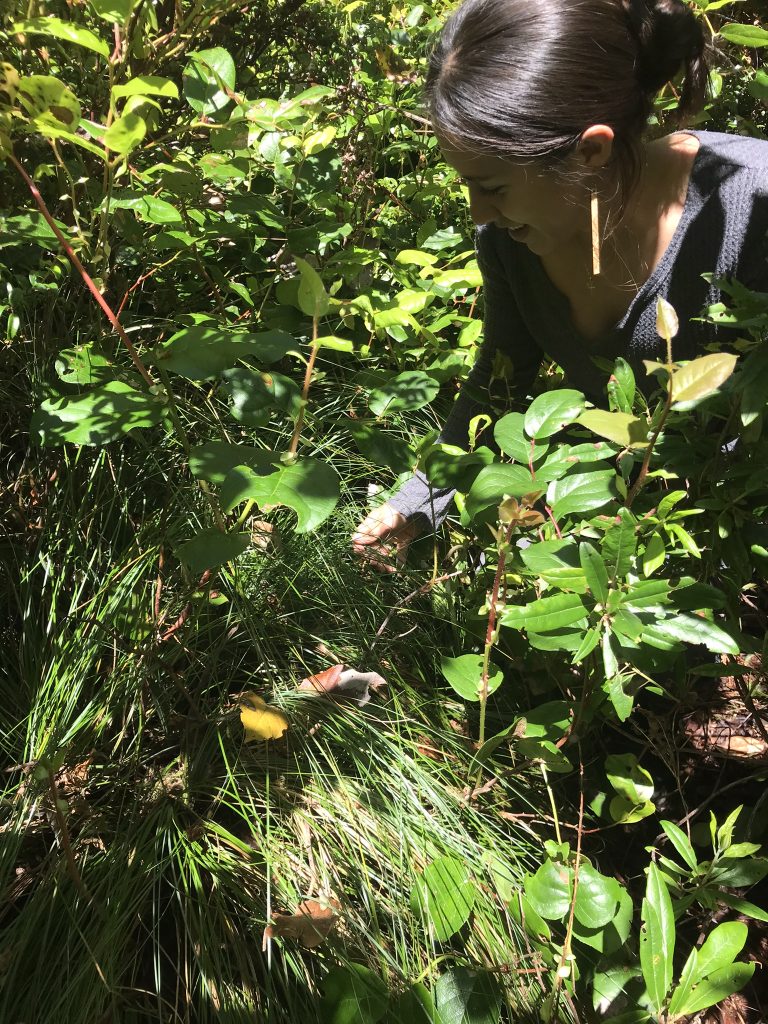
During my first year in GES, I remember feeling the differences between my high school
and the university, as it was my first time being surrounded by peers who were all interested (and some already experienced) in science and who came from a variety of backgrounds. I remember being somewhat intimidated by research and the undergraduate thesis aspect of the GES program. Joining the Maile Mentoring program my freshman year helped me to gain valuable guidance and mentorship in identifying my interests and needs. This program also showed me the importance of cultivating connections and friendships in the GES program, which, over time, helped me to feel less alone in beginning the research process and navigating the curriculum that I struggled with in some classes. Through the Maile Mentoring program I was also connected with my thesis mentor, Dr. Henrietta Dulai, who guided me in my first research experience working to identify potential threats to a local farm in Hawaiʻi that may also be exacerbated by climate change.
My undergraduate experiences, both inside and outside of GES, allowed me to better understand all parts of my identity. Stepping into my first research experience and interning with the National Oceanic and Atmospheric Administration (NOAA) showed me how science can be used to benefit communities close to my heart, either by designing outreach materials, identifying potential threats to water, or helping to revegetate ecologically and culturally significant plant species. Outside of GES, I also learned the importance of making space for growth in other aspects of my identity through Hawaiian language courses, hands-on work days, and participation in student clubs. I also made space for participating in a new Bachelors-and-Masters pathway through GES which allowed me to “double dip” finance courses towards a Masters in Finance, which I will hopefully complete one year after graduating from the GES program.
All of my curricular and extracurricular activities during my time in GES have shown me that cultivating growth in all aspects of your identity and understanding your role in your community are powerful tools for generating meaningful projects and research, which I hope to build on and learn more about in the future. Understanding the systems that we live in, whether cultural, financial, or political, are valuable in science, since science can rarely optimally function in a silo. I am constantly learning that participating in scientific research does not always require identity to be centered around science and I would encourage future GES students to continue pursuing outside interests and cultivating relationships with family, community, and personal identity while going through the GES program.
In the future, I hope to maintain and build upon the things that I have learned from many
amazing professors and mentors in the GES program. I also hope to possibly pursue a PhD in
ecology sometime in the future while reflecting upon the many lessons that I continue to learn about science and about myself.
Published on September 7, 2023.
I first heard about NOAA’s Ernest F. Hollings Undergraduate Scholarship in high school when my older cousin participated in the program during her undergraduate degree. Being interested in oceanography and a GES major, the Hollings program was something I definitely aspired to as well. The Hollings program is an academic scholarship and paid summer internship that pairs students in their third year of their undergraduate degree with a NOAA office and mentor. Students complete a project that aligns with NOAA’s mission and present it at the end of the summer. Projects can be very technical and science-focused, or can be geared towards outreach and education.
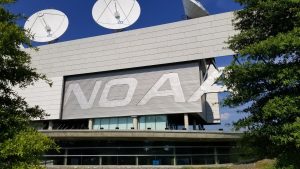
Once I was admitted into the program, I had to select a mentor and project, which felt very similar to finding a mentor for the GES thesis project. There is a project for everyone, but some require more technical skills and appeal to different interests. In the end, I was torn between internship location and project topic. I matched with a mentor in Alaska doing a project I was less excited about but also matched with a mentor in Suitland, Maryland doing a project I loved. Ultimately, I chose to go to Maryland where I interned at the US National Ice Center assessing different satellite product’s performance in estimating sea ice thickness. USNIC is a tri-agency operational center, meaning I got to work alongside people from NOAA, the US Navy and the US Coast Guard.
I have always been interested in arctic science and particularly sea ice. The state of the Arctic is an important indicator of Earth’s climate and changes happening in the Arctic due to climate change could have global implications. Estimating sea ice thickness is important for climate-related predictions, and it is also important for providing operational support for marine traffic in the arctic. For my project, I compared sea ice thickness data from the SMOS and SMAP satellites with thickness data from SAR satellites like CryoSat2. My project required Python and QGIS, which I have some experience with and which is part of the reason I was a strong candidate for this project. Due to Covid-19 levels, I ended up working from home about half of the time and the end of summer symposium was canceled, so I could not attend. Still, I had an amazing time at USNIC and engaged DC during the week when I was working from home. Talking to the employees at USNIC, I learned so much about the opportunities for studying sea ice and for ship-going work in the future. I also made great connections with people in a field I am very interested in and got to ask them questions about their career journeys.
Even though I was hesitant about going to Maryland this summer, I ended up enjoying it immensely. I lived in Capitol Hill in Washington D.C. There was tons to do, and people were super friendly and welcoming. Before this experience, I never wanted to live or study in this part of the country, but now that the summer is coming to an end I will be sad to leave. This experience has definitely widened my perspective as far as what I want to do after I graduate. Approaching my senior year at UH there are a lot of unknowns about what comes next, but talking to people and working in a professional environment this summer has eased a lot of my anxieties about what comes next and opened my eyes to opportunities I did not know existed or were available to me. Overall, it was an amazing, fun, and educational summer that I would recommend to anyone interested in a field that aligns with NOAA’s mission.
Published August 16, 2022.
My name is Madelyne Harding and am currently a GES major. I transferred to GES from Marine Biology when I had really discovered a love for all ecosystems and did not want to be limited to just marine ecosystems. I am so happy I did as it has led me to my current internship with Army Natural Resources Program and am assigned to the vegetation restoration team. Our main job is picking, planning, clearing, and maintaining areas owned by Army to become protected restoration sites. These restoration sites are then used as out-planting spots for native/endemic Hawaiian plants. We monitor the sites by weeding, taking photos at photo points, seed scatters, grass spraying, aerial surveys, and road surveys. From road surveys, I have learned about the dreaded weed Chrysopa Dorsalis (chrodo) that is spreading wildly, earning the nickname “Devil weed”. After a two-day survey it haunted my dreams, dreaming that I found it in new areas it originally was not. Thankfully most of the plants we deal with don’t cause nightmares. One of my personal favorites is the Cyanea superba, which reminds me of the Truffula trees from The Lorax. This plant is endemic to Hawai’i and is wildly extinct. The plants we see today were propagated and planted by different facilities throughout the island and exist only in fenced-in areas.
Other work in these restoration sites that my team creates are the implication of our “snail jails”. The snail jails are structures made to have native plants and endemic endangered snail populations inside them. The program manages primarily Achatinella mustelina. The snail jails consist of a wall that at the bottom has a lip protruding at about a 15 degree angle this angle is important as it helps trap a cannibalistic, carnivorous snail, commonly referred to as the rosy wolf snail (Euglandia rosea), from entering the enclosure and devouring the endangered endemic snails (rosy wolf shell structure shown in photo). If they get past this line of defense a copper wire is on the structure that has a low current of electricity on it is the next line of defense that will shock the predator enough to knock it off the wall. Other threats to the snails include rats, birds, Jackson chameleons and climate change.
This internship has taught me valuable field skills and opened doors to learn about Hawai’i’s diverse microclimates and the organisms that exist in them and the importance of protecting the endemic species of Hawai’I for their ecological and cultural importance. I am truly honored I get to work so closely and help with the management of so many endangered species.
Published August 15, 2022.
The City & County of Honolulu’s Storm Water Quality Division (SWQ) strives to protect Hawaiʻi’s greatest assets: our clean water and the vitality of our diverse ecosystems. I am grateful to have been accepted as a 2022 summer intern. The Department of Facility Maintenance Storm Water Quality Division is made up of three branches. Investigations and Enforcement, Compliance and Inspections, and Public Outreach and Education. Each branch has its own tasks to help support the compliance guide or Storm Water Management Program Plan (SWMPP). Through the State of Hawai’i, we abide by the National Pollutant Discharge Elimination System (NPDES) Municipal Separate Storm Sewer System (MS4) permit. This permit is a guideline for how we revise the SWMPP for the future. Effectively, the Clean Water Act authorizes the State of Hawai’i to administer the NPDES Permit onto the City’s SWQ for Illicit Discharge Detection and Elimination (IDDE).
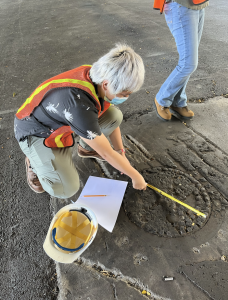
During this internship, I learned that efforts to keep the water clean are also mandated at the federal and state level under the NPDES permit. Federally, municipalities with their own storm drain systems are required to obtain an NPDES permit from their state. The permit requires local governments to implement Best Management Practices (BMP) in order to minimize pollutant discharges. As a division, each branch contributes to the SWMPP. Our Investigations & Enforcement (I&E) branch focuses on following up on complaints regarding illicit discharge and illegal drain connections into the city’s MS4. Moreover, I&E follows up on boulder basin inspections, street sweeping analysis, and community outreach. Compliance & Inspections (C&I) is in charge of following up on current and post construction sites for necessary building permits, industrial and commercial facilities, BMP inspections, and stream monitoring. Public Education & Outreach (E&O) involves organizing storm water management support methods by connecting with the public at various levels. This includes social media, volunteer projects, and educational events.
An average week working for the city’s SWQ was a blend of field and computer work. As an intern, I was exposed to many of the tasks that go into supporting the SWMPP. In the field, following the IDDE I helped gather data related to investigations and inspections. This included inspecting city owned infrastructure for any damages, unusual storm water flow, street sweeping analysis, and stream water collection. On the outreach side, I got to help with public education to inform communities about keeping the stream channels clear and to encourage keeping our streets clear. All the data collected through each initiative is later compiled into Cityworks then constructed into an annual report for determining revisions to the SWMPP. One of the major projects I got to work on combined all three branch initiatives. This included using various ESRI products to compile stream monitoring data to design an ArcGIS StoryMap template for public education.
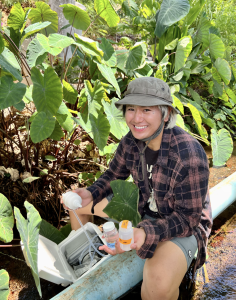
As a GES student, I know that the ocean has strong impacts on the quality of Hawaiʻi’s health. The hydrologic cycle is a biogeochemical cycle that continuously circulates water above and below the surface of Earth. It plays a vital role in the water cycle, marine life, and the health of Hawaiʻi’s people and ecosystems. This was really important to me because clean water is a precious natural resource required for sustaining life. Furthermore, storm water and its affiliation with the NPDES has made me think about its relation to my GES research. My thesis analyzes distribution patterns of pathogens in a wetland environment. The site location for my research is in Sumida Farms, a freshwater spring farm that grows the bulk of Hawaiʻi’s watercress. Although the springs are the main source of nourishment for the farm, during heavy rain the runoff travels into the farm carrying pollutants from the nearby urban infrastructure. This has made me more aware of the potential implications of any water entering the city’s MS4 and supporting my overall goal to protect Hawaiʻi’s clean water.
Published August 16, 2022.
From a very young age, I knew that I Ioved the ocean. Growing up as a California native, I had
the opportunity to explore the coast and grew fascinated by sea life. Some of my first memories include watching The Undersea World of Jacques Cousteau with my dad on DVDs, and spotting dolphins, seals and the occasional whale from the beach.
My interest in the ocean deepened in high school when I became PADI certified, and I knew I
needed to attend a college that allowed me to develop my passion even further. When applying for colleges, the GES program at University of Hawaiʻi at Mānoa matched my interests and goals. The broad range of classes and electives have helped me establish a strong academic foundation. The GES program and support of staff as well as the Marine Option Program has created opportunities for me to pursue research projects that have been nothing short of incredible.
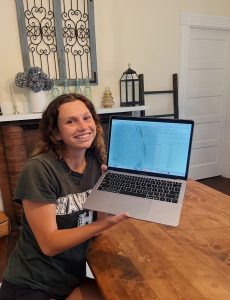
While a volunteer at the Health and Stranding Lab in Kāneʻohe, I responded to cetacean stranding, collected baleen samples for hormonology, quantified marine debris stomach content, and was involved in subsampling, necropsies, and other lab work which helped to focus my interests. This led me to my UROP-funded thesis, Blubber Histology and Hormonology of Striped Dolphins. I am currently working on this project, and will be examining blubber quality across the body of the striped dolphin using histological methods to provide baseline information on the distribution of blubber and how it relates to body condition and nutritional status. I will also be extracting hormones to compare cortisol concentrations between striped dolphins of different life histories and body conditions. My data will be compared with an existing data set to ultimately determine what regions of the body are most important to energy storage and nutritional health, which would inform future health assessments of live animals of this species as well as examine the role of stress in the nutritional status of stranded striped dolphins.
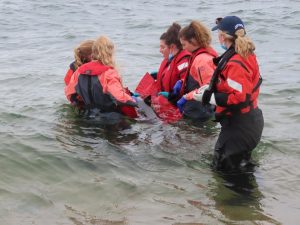
This summer in addition to working on blubber data for my thesis, I am an intern at the International Fund for Animal Welfare in the Marine Mammal Rescue and Research division (IFAW MMRR) on Cape Cod, MA, a global marine mammal stranding hotspot. With IFAW MMRR, I have monitored sick and injured seals, collected Level A data on seals, and responded to a variety of marine mammal strandings. I have also participated in necropsies, teeth extractions from deceased animals, data compilation, and provided supportive care to live stranded cetaceans, including Long-finned pilot whales and Harbor porpoises. Recently the IFAW MMRR team and I rescued and released four Atlantic white-sided dolphins that were part of a mass stranding event.
Through my classwork, internship, and thesis, I gained not only classroom knowledge but also hands-on experience in the field and in the lab. The opportunities I have had have inspired me to pursue a career path with marine mammals and I hope to be a stranding biologist in the future.
Published August 15, 2022.
After spending two years at the University of Hawai’i at Mānoa enrolled in the Pre-Engineering program with plans to transition into Civil and Environmental Engineering, I realized my passions were more focused on sustainability and environmental science rather than
Civil Engineering curriculum. This is when I decided to find a major that was more aligned with
my interests. While looking for a new major I was seeking one that was more flexible and
had opportunities in different directions. I wanted a major that had a wide scope of curriculum
related to sustainability, global earth and ocean sciences. Using these factors I found Global
Environmental Science; a perfect match. Shortly after communicating with some of the fantastic faculty in the program, I knew that this was the right major for me.
Finding a mentor and project took a bit longer than expected as I switched into the program at the beginning of the pandemic, and typically I am more successful at making connections face-to-face. But luckily while working with my academic advisor at the time, Dr. Michael Guidry, he put me in contact with Dr. Godwin Severa, because he knew I wanted to work on something related to renewable energy, sustainability, or oceanography. Dr. Severa presented me with a project that he had in mind for me, where I would be working on improving acidic gas contaminant mitigation methods, to further improve fuel cell efficiency. This was a perfect fit, and even though I knew very little about the science behind this field, I saw it as a perfect opportunity to be able to expand my knowledge and improve learning a new methodology.
Throughout working on this project, I have learned endless amounts of skills to be able to carry on after I graduate. I think the biggest skill that I took away from this is independence, which has many skills that come with it such as self-motivation, initiative, confidence, dependability, organization, planning, and problem-solving. These skills are something that I was lacking prior to starting this project, and moving forward these skills will be so incredibly useful going into the workforce. Especially now since the workforce is shifting to remote jobs, the need for workers that are independent and self motivated is increasing exponentially. Post-graduation I hope to find a career that mirrors my interest in either renewable energy, physical
oceanography and/or preservation. The curriculum and experiences I had with the Global
Environmental Science program has enabled me to be eligible for the goals and careers that I
want to achieve, and I will be forever grateful for that.
Read about Jacob’s story in the news and first-place poster presentation!
Published August 16, 2022. Updated November 8, 2022.
When most students think of research projects, they become easily overwhelmed. The
thought of finding a project that would suit their interests, connecting with a good mentor, and just finding the time to conduct the research on top of their coursework can seem like a big commitment. My name is Tanner Ritchey, I am from Ewa Beach and recently graduated from UH Mānoa with a Bachelor of Science in Global Environmental Science. In this short article I will cover the process that I went through to complete my research project. Hopefully, this will alleviate some concerns students have when debating whether or not to take on a research project.
During my first two years at the UH Mānoa I was studying physics. However, when classes went completely online at the beginning of the pandemic, I found it difficult to continue 300- and 400-level math and physics courses. After a few conversations with my academic advisor and some research of my own, I decided to transfer to GES. One of the things that encouraged me to switch to GES was that there was not a language requirement, (saving me hours per week in course work). However, once I began my classes I realized how much the GES program really had to offer and the variety of research that was available. One thing that really put me at ease was the classes that are integrated into this major which are specifically focused on helping students figure out what they want to do research on. They also help get students in contact with potential mentors, and guide students through the process and timeline of the research project. Faculty and staff in the GES program are knowledgeable and very responsive which made it much easier to find a project that best fit my interests.
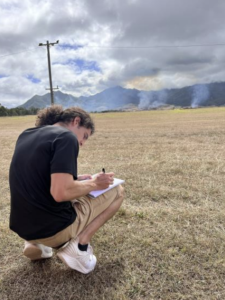
I chose to look into fire ecology, more specifically wildfire mitigation techniques i.e. prescribed burns. I was interested in this field because my dad was a firefighter throughout my childhood and I found out that over 95% of wildfires in the U.S. are caused by human activity. Through this research I made connections with multiple fire departments, the Army Garrison Wildland Fire Department, and wildfire experts with the DLNR’s Division of Forestry and Wildlife. I spent a few days observing an annual control burn conducted by the Army Garrison Wildland Fire Department at Schofield Barracks. I learned about prescribed burn plans, procedures, and techniques from this experience (more than I was able to include in my thesis). I plan to use the knowledge and experience I gained to further a career in structural and wildland firefighting or wildfire mitigation operations on the mainland’s west coast.
Published August 16, 2022.
As I enter my senior year at UH Mānoa, it is a time of reflection and excitement as I embark on all that comes with being a final year Global Environmental Science (GES) major at SOEST. I started my college career in Manhattan at The New School, where I studied film production. While in New York, my interests shifted towards policy as the politics of this country were becoming more dividing.
I have always loved earth science and environmental injustice studies. I was never attracted to spending my time in a lab, which is what I originally thought defined a science degree. That of course is not true, and through my education at UHM I have been able to find how I fit into the world of science with my various interests.
The industrial human superiority mindset that involves controlling every aspect of life on this planet is what draws me to environmental policy and law. There is no greater area of importance than understanding the complexity of regulating life in a dramatically changing climate.
My curiosity of how humans interact with each other and the environment is ultimately what brought me to this area of study, and more specifically my senior thesis project. I connected with National Oceanic and Atmospheric Administration (NOAA) social scientists Kirsten Leong and Danika Kleiber. They are currently working to emphasize and document the importance of social science within fisheries, and more specifically within NOAA fisheries. Leong and Kleiber are my mentors, with the help of Dr. Jeff Drazen, who is both my academic advisor and faculty mentor for this project.
This project aims to identify the documentation of social science within federal, regional and local policy that are not emphasizing the importance of this science at NOAA fisheries. Social science is an essential part to fisheries management, but it has been consistently viewed as secondary. This project is answering the question of both why is social science on a backburner, and what important roles it can play as a properly funded area of research? I am specifically interested in evaluating the cultural, economic, and environmental impacts of fisheries.
The project will involve reading and analyzing literature that discuss the current role of social science both on a general scale and within NOAA fisheries. The Magnuson-Stevens Act which regulates fisheries management in the United States is one example that I will be reviewing. A statistical analysis using MaxQDA software will highlight where there are opportunities for social science.
To complete the work for my project, I will work for the Cooperative Institute for Marine and Atmospheric Research through UHM. This will allow me to have access to necessary software such as MaxQDA that I will need to use throughout my project. Reading and understanding the statistical analysis that the project creates will be done from my home and coffee shops all over Honolulu.
Not only does this project perfectly combine all of my interests of the human experience with the environment and policy, but it also allows me to learn as much as I possibly can about fisheries management.
Published July 27, 2021.
Rather than watching animations or playing video games, reading geography books and the atlas were two things I was enchanted with in my childhood. In high school, I found I have a huge passion for exploring and taking care of our planet. Therefore, I had been thinking for years how I could take care of our planet. The first thing that came to mind was that I must use the latest technology to protect the environment. Since we are in the era of big data, the Geographic Information System (GIS) is the latest and most effective tool to protect the environment. When I was thinking about my major in UHM, there were many options for me: Geology, Geography, Natural Resources and Environmental Management, etc. However, I found the GES program is the best fit for me because the courses in GES will prepare me to have a solid background in Earth system science. Therefore, I decided to major in GES. Unlike many Chinese families who push their children to study in business, engineering, medicine, or law, my family supports my choice and dream (many thanks to my family!)
Environmental science is a very broad field, once I got into the program, I started to think of which track I should go. I found environmental planning is an important topic because the worldwide rapid urbanization process has to respond to the changing climate. Today, over half of the population lives in cities, but many cities are not eco-friendly. The non eco-friendly cities are neither healthy for the Earth nor livable for humans. GIS is a strong tool in planning, it helps us digitize and visualize what’s going on in the real world and make predictions of the future, and help us to build eco-friendly cities. GES and the Department of Urban and Regional Planning have a Bachelor’s and Master’s (BAM) pathway which allows students to graduate with Bachelor’s and Master’s degrees in 5 years. In addition, the Department of Geography has a Certificate in GIS, which helps students set up a fundamental understanding of GIS. Therefore, I have decided to pursue the GES & MURP BAM program and the Certificate GIS.
As an international student, I am excluded from many opportunities. Therefore, I cherish every opportunity I am qualified for. After talking with some professors, I found there are two programs I should go for: Undergraduate Research Opportunities Program (UROP) and Honors Program. UROP offers funding for undergraduate students engaged in faculty-mentored research work, and the Honors Program is a great platform with various resources, and it encourages students to conduct independent research in professional quality. I greatly appreciate my faculty mentor Dr. Suwan Shen. With her guidance, I received funding from UROP for three consecutive semesters (Spring 2021, Summer 2021, and Fall 2021) and my application to the Honors Program was accepted as well.
In Spring 2021, I conducted my first research project. I applied geospatial data of Oahu to figure out how sea level rise in Oahu will affect the existing house system. At the beginning, I had no idea what I should do, but Dr. Shen always encourages me with a lot of patience. Finally, I had all the results and presented my results in the Undergraduate Showcase. I was astonished by the result of my research: a 0.5 feet sea level rise will influence about 3,000 housing units in Oahu and the total value of those properties is up to sixty billions. After the research in the spring semester, I have a better sense of the importance of environmental planning. This summer and fall, I will focus on how housing for vulnerable populations (e.g. nursing homes and senior residences) respond to sea level rise.
My senior year is coming up, the UROP project for summer and fall will also be my GES thesis topic. I also accepted the admissions offer of the GES & MURP BAM pathway a week ago. I can’t wait to see what I can help to contribute to society in the future!
Published June 29, 2021.
I chose this topic because I have an interest in learning more about city sustainability. Exploring the potential for incorporating urban agriculture can be one way to support sustainability within a city. For instance, it could reduce the reliance on imports which could in turn decrease carbon emissions from transporting food into the city. My thesis mentor for this project is Dr. Priyam Das from the Department of Urban and Regional Planning. My project looks into the different steps required to implement urban agriculture and how viable it is in Honolulu specifically. I am interviewing experts from different sectors (private, public and non-profit) to ensure a well-rounded view on what needs to be done for urban agriculture to be implemented in Honolulu. This project will also be looking at other cities as case studies to see how they have issues such as zoning and land-use regulations.
So far, I have found that looking at urban agriculture as the only solution to ensuring a more secure food system in Honolulu may not be the way to think about this. By substituting one means of getting food to Honolulu with another, the level of risk is not being lowered but simply transferred. In order to build a stable food system, there has to be several components at play. I will continue to gather data through the interviews with experts as well as information from published research and peer-reviewed papers. I will then analyze the interview transcripts by conducting a thematic analysis. I received funding from the Undergraduate Research Opportunities Program for the Spring and Summer 2021 sessions which helped to motivate me to continue this research and also allowed me to present in the Summer Undergraduate Research Experience symposium at the end of Summer 2021.

This word cloud was made using keywords that emerged from my initial interview transcripts. I thought that this would show some of the main topics that these experts thought were most important in relation to urban agriculture. Land is the word with the highest frequency which makes sense as it is one of the first issues that has to be addressed and one of the hardest to allocate to urban agriculture due to zoning regulations.
I am half-American and half-Luxembourgish, but I grew up in London, UK. I decided to study GES because I always had a love for the environment and sustainability and could never understand how people could treat it so carelessly. I chose this major in order to find ways that we can help the environment and put them into action.
Published September 14, 2021
While I knew I wanted to study environmental science long before I began my undergraduate career in SOEST, it wasn’t until I wrote my first paper on micropollutants that I found myself completely encapsulated by a research area. In my third year, I was reaching out to anyone I could think of to find opportunities with marine contaminant research. Dr. Roger Babcock of the Department of Civil and Environmental Engineering referred me to my current mentor, and suggested that I look into a manufactured chemical I hadn’t heard of, called perfluorooctanoic acid, or PFOA. When I began to dive into the literature, I was absolutely appalled. PFOA, it seemed, was in everything; from products like non-stick pans, textiles, and the linings on pizza boxes to military-grade fire fighting foams and much more. The family of chemicals it belongs to completely lack the ability to degrade in the environment, and have been linked to a huge array of negative impacts to human and animal health, such as decreased fertility, enlargement of the liver, and decreased kidney function (just to name a few). Studies had been performed on a limited number of species, but no research had yet looked into how the compound affected coral reefs. Therefore, under supervision of Dr. Robert Richmond at Kewalo Marine Laboratory, my thesis project aims to determine how exposure to different concentrations of PFOA would affect coral reproduction and viability on Oʻahu. With the help of PhD candidate, Alexandria Barkman, and other graduate students in the Richmond lab, I have since performed multiple exposures of PFOA on various phases of the coral life cycle. After collecting egg samples in Kaneʻohe Bay during a coral spawn in June 2020, I observed the fertilization success of rice corals (M.Capitata), and quantified the rates of their larval survival with exposure to real-world concentrations of PFOA.
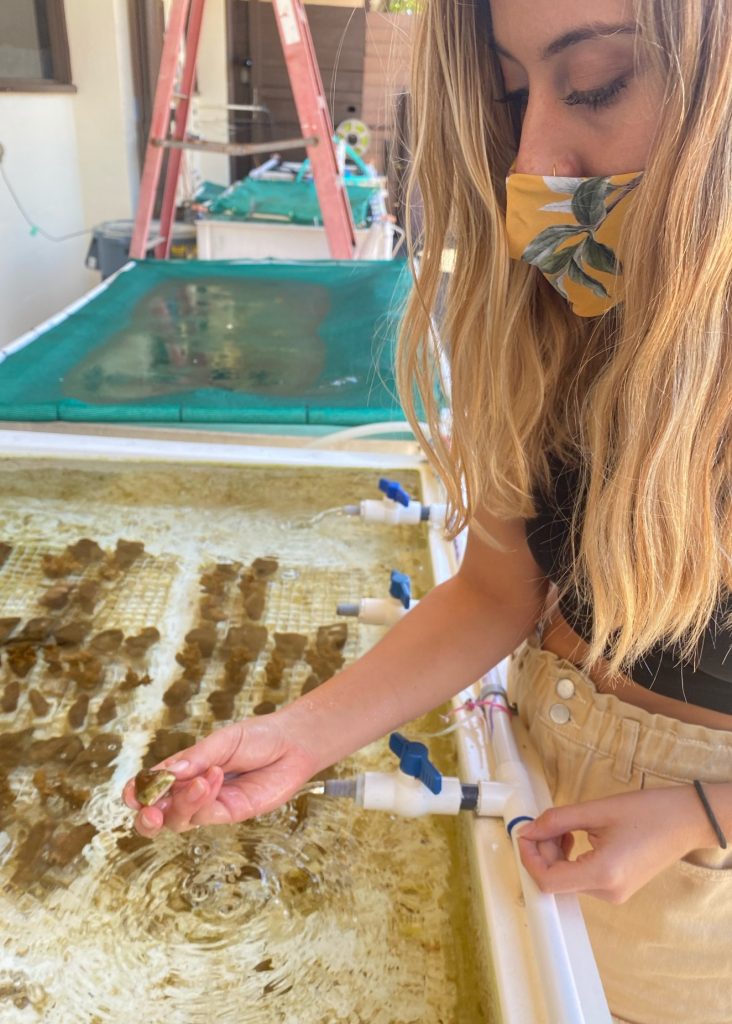
I also wanted to determine the effects on adult coral species, and organized a three-and seven-day exposure experiment on lobe corals (P.lobata). Over the experimental period, I looked for signs of bleaching and other indicators of stress, but you cannot always visually observe the sublethal effects on any organism. So after the exposure periods, I extracted the proteins from each coral sample and performed molecular analyses to see if there were any sublethal indicators of stress after exposure. This allows us to see the potential impacts to coral function that I couldn’t see with a naked eye (such as detoxification or resistance to marine viruses).
While the analytical portion of my research has yet to be completed, PFOA has been observed to directly interfere with fertility and reproductive success of other organisms. Therefore, I am anticipating that the most noticeable impact on coral reefs will be in their fertilization success and protein expression. The reason for this being that prior studies on exposure in other species have resulted in interference in reproductive capacity, which occurs at a sublethal, hormonal level that could be detected through the molecular techniques we used in the lab. Ultimately, PFOA is an extremely widespread pollutant around the globe, and determining its effects on coral reefs is a vital step towards promoting its management in marine systems in the future.
Published July 23, 2021.
The degree in Global Environmental Science (GES) at the University of Hawai‘i at Mānoa allows the opportunity for students to conduct their own undergraduate thesis project. For my project, I wanted to focus on the impact of climate change on the earliest life form of an intertidal species.
My interest in invertebrates originated from a biology of invertebrates class offered at UH Mānoa by Dr. Amy Moran, who worked with me as my thesis project mentor. After I took her course, I found I was fascinated by marine invertebrates and wanted to know more about Hawaii’s species. Carrying out my thesis with this species of false limpet has fostered my passion for the often unnoticed creatures that live in or around our oceans.
My subject species is Siphonaria normalis, a small, abundant false limpet that litters the rocky intertidal regions of O‘ahu, Hawai‘i. These tiny snails inhabit the upper intertidal where they endure high wave action and hot temperatures while grazing on algae. As grazers, they hold an important role of algal control on Hawai‘i’s rocky shores. They stubbornly suction themselves to rocks and use their cap-like shells to protect themselves from overheating as well as the tides. However, there is an aspect of this species’ life cycle that is not as easy to observe: the egg masses in which they grow up.
Siphonaria normalis deposits egg masses in the high regions of the rocky intertidal, allowing embryos to develop in the same hectic habitat as adults. Embryos develop in capsules within the egg mass before metamorphosing into juveniles and emerging from their capsules. During this process, they form their shells, eyes, and foot, which is eventually used to crawl and suction onto the rocky surfaces. Unable to protect themselves from heat in the same ways as the adults, I raised my question: How would experiencing a hot temperature event within their early development affect the ability of Siphonaria normalis embryos to survive and develop? To better predict the future distributions of these abundant grazers in the face of a warming climate, I wanted to understand where their current thermal tolerances lie.
To accomplish this, I studied the survivorship of Siphonaria normalis embryos in response to high temperatures. I predicted that, at high enough temperatures, embryos would not be able to complete their development into the shelled life form (shown above) before dying. At elevated temperatures, embryos began to show developmental issues. Many showed bulging cells, discoloration, and the inability to develop important features such as shells and eyes. My results indicate that the surface temperatures of intertidal zones in Hawai‘i, where Siphonaria normalis live and reproduce, are already reaching these dangerous temperatures.
If we want to see the big picture of climate change and its effects on many species, we must include the smallest organisms. From thermal tolerance studies, we can start to predict how a warmer climate will impact living things. Studying the vulnerable life stages of ecologically important species, such as Siphonaria normalis, is critical to future environmental science research.
While pursuing my degree in GES, I also worked to obtain a certificate in the Marine Option Program (MOP). MOP is a certificate that adds an ocean emphasis on an education pathway by requiring marine-related coursework as well as a special skills project. It was through MOP that I was able to complete a research project through the OPIHI (Our Project in Hawaii’s Intertidal) internship. I was also introduced to other opportunities, such as the Shark Lab Internship at the Hawaii Institute of Marine Biology that I currently still maintain. My pursuit of a GES degree paired with a MOP certificate has been a valuable combination as I seek out future opportunities in research and preserving Hawaii’s biodiversity.
Published July 23, 2021.
This past year has undoubtedly been difficult, and much of everyday life has drastically changed. Through all of the distancing and lack of social interaction, working on my GES thesis has given me something to focus on and has provided an amazing distraction.
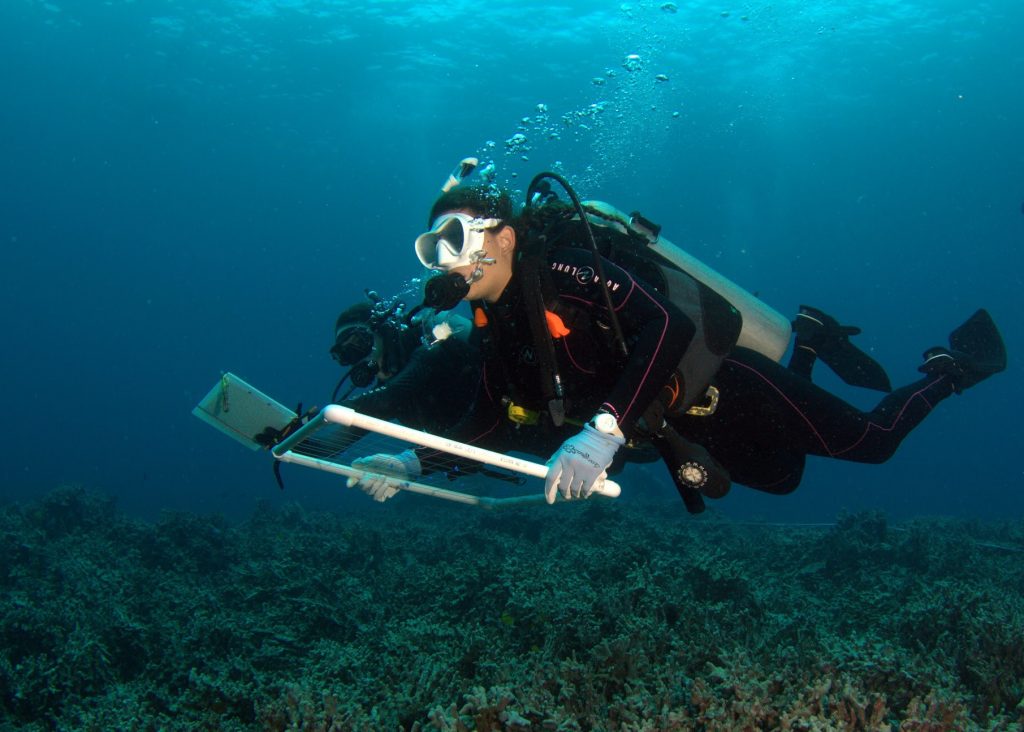
I came to Oʻahu knowing that I was interested in marine science, but lacked understanding of the actual field and what specific interests I had. From the first orientation, the GES program exposed me to many different possibilities of research and projects, and provided information on many outlets, from internships to lab jobs to volunteer work, to discover what I was passionate about. I volunteered with the National Oceanic and Atmospheric Administration (NOAA) and got a job at the UH Dive Safety office, both of which helped me discover my love for scientific diving and field work.
My GES thesis, under the mentorship of Dr. Chris Sabine, examines microplastic concentrations on the surface of the inner, middle, and outer sections of Kāneʻohe Bay, Oʻahu. This data is gathered using surface plankton tows. The organic matter is then digested out of the samples, with plastic fragments remaining. They are mounted on slides and counted, and then confirmed using Raman Spectroscopy.
Coral health surveys are taken in the areas that the plankton tows have been conducted in using Hawaiʻi Institute of Marine Biology’s Koʻa cards, and coral health will then be compared to microplastic concentrations, looking for a possible correlation. There is an outreach aspect of my project in which I am distributing Koʻa cards to the community as they are designed for use by everyone, from citizen scientists to recreational beachgoers.
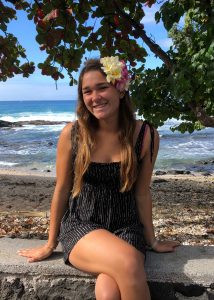
My thesis work has been funded by the Undergraduate Research Opportunities Program (UROP), as well as the Pacific Islands Climate Adaptation Science Center’s Summer Undergraduate Research Fellowship (SURF). The UROP funding has enabled me to print 100 Koʻa cards, and the SURF fellowship is currently providing me with a stipend and a network of people to begin distributing the cards.
I expect to conclude the field work portion of my project by the end of the summer, and will begin writing up the thesis at that point. I will be presenting my work in August 2021 at the SURF symposium.
My GES thesis has been an amazing outlet to be able to conduct research and work towards something in a time when not much is going on and motivation can be difficult to achieve. The GES program has provided me a way to keep busy and do something that I love in these troubling times, and I am continually grateful for that.
Published June 29, 2021.
The GES program has given me many opportunities to broaden my personal and academic horizons. Born and raised in Hawaii, I entered college knowing that I wanted to study abroad to expand my worldview. Other than the exchange program, I didn’t know what else UH Mānoa and GES had to offer. I then heard of all the different paths that other students had during the GES orientation—from going abroad or on cruises for research to getting internships during the summers—and it all seemed overwhelming. But I soon learned that taking small steps forward as doors opened was the key to an enriched college experience, and I want to share some highlights from my journey.
In my first year, upon hearing about a lab position open from one of Dr. Michael Guidry’s emails, I was able to apply and land a student research assistant position at the Strategic Monitoring And Resilience Training in the Ala Wai Watershed – SMART Ala Wai team where I learned the basics of working in a chemistry and biology lab and doing research and scientific outreach. After listening to GES alumna Natalie Kwa speak in my OEST 100 class, I followed up with her about a possible internship, which eventually led to my hiring as an environmental monitor shadow full time during the summer.
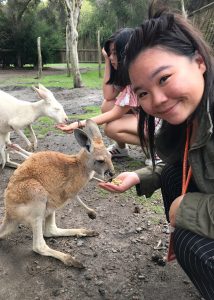
In the spring semester of my second year, I studied abroad through the Mānoa International Exchange program. I filled out the application about a year in advance with now-retired SOEST advisor Leona Anthony’s letter of recommendation, as I didn’t have any professors who knew me well at the time. I had trouble finding courses that would transfer over into GES so I only took classes that fulfilled my secondary degree, economics. I had applied for economics after taking an economics class that piqued my interest in the first semester and realizing many concepts that applied to sustainability and environmental impact. During my time in Australia, I was able to connect with people from different backgrounds and grow a bit more independent. I was intrigued by Canberra’s advances in protecting the environment so I wrote a paper about it and later refined and published it in the campus undergraduate journal Horizons. I highly recommend studying abroad if you can plan to take your basic courses overseas, as some higher-level GES courses are quite niche and difficult to find equivalents elsewhere. In this sense, the phrase “the earlier, the better” applies to going abroad for a semester of study; additionally, you never know when the entire world is about to shut down.
It is impossible to conclude my college experience highlights without mentioning the pandemic. When my life was transformed entirely due to social distancing and remote learning, it was my GES classmates who kept me sane. The online Discord community we created became a great source of mutual support as we went through struggles together. Under these unusual circumstances, the GES program continued to bring pivotal opportunities to me. Dr. Guidry had connected me with Dr. Michael Roberts from the Department of Economics during my third year in 2019. And in my fourth year, during the pandemic, I started my thesis on agriculture and climate change and received funding from the Undergraduate Research Opportunities Program with Dr. Roberts as my mentor. I also contributed to his paper on temperature-sensitive shiftable energy which I am very excited about. In a short period of time, I’ve learned a lot about economics research technicalities and culture from my mentor and elevated my data visualization skills in R, which is an experience I couldn’t have gained otherwise.
I’m thankful that GES has been part of my college journey not only as a program of quality courses but a program that opens the door to many interesting career pathways, rewarding opportunities for growth, and strong friendships that will last.
Published August 5, 2021.
As a 2021 GES undergraduate of University of Hawai’i at Mānoa, my mentor Mark Glick, of the Hawaii Natural Energy Institute, and I focused on the socioeconomic impacts associated with climate induced migration from Central America. With average global temperatures increasing, environments are physically changing in various ways such as drought, desertification, and extreme weather events. These issues are accompanied by social complications of the past and present leading to disparities such as famine, unequal land distribution, and unemployment. Combining the physical and socioeconomic conflicts can lead individuals seeking for methods of sustenance, which can ultimately lead to migration as a form of adaptation.
Informative meetings between myself and my mentor lead me to lengthy sessions of research analyses of expert authors from around the world. Alternating between the bright beam of a bedroom lamp and the light breeze of the California autumn, my eyes were fixated on extensive sources of emigration data, agricultural knowledge, and the socioeconomic history of multiple Central American countries. For instance, Sadanista control of Honduras during the Cold War transported me to a time period full of hardship and turmoil at the threat of American intervention.
Bodenheimer, Rebecca. “History of the Sandinistas in Nicaragua.” ThoughtCo, 20 Dec. 2019,
www.thoughtco.com/sandinistas-in-nicaragua-4777781.
Moreover, the emergence of the Green Revolution shifted my focus to Mexico where the agricultural economy began to decline in exchange for industrialization. As recent timelines began to materialize, Guatemala and El Salvador became an important subject of study with the greatest percentage of migrants. Ultimately, the journey concluded in the United States, which not only served as a refuge for prospective emigrants, but also as an entity that can affect future migration patterns. Each paper transported me to various regions across the world while case studies allowed me to empathize with the struggles imposed by the development of the first world.
As with any extensive project, issues were encountered along the way; especially amidst a global pandemic. The resources available at my disposal were greatly reduced since I was forced to relocate back to my childhood home for the duration of my college experience. Although, this move allowed me to focus on work without significant social distractions, which could have served as a potential benefit to the process. Furthermore, this move also put me back in Southern California where a large deal of Central American migrants reside.
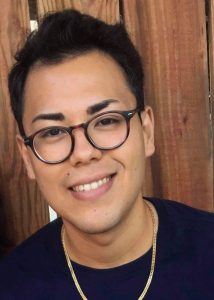
In terms of content, some of the most difficult aspects of my research was connecting scientific data with political and economic theory. In addition, disparities of Central America’s past added another factor that changed the general landscape of my results and future recommendations. However, through conversation, guidance, and support from my mentor, we were able to synthesize a historical timeline of agricultural development/degradation in Central America. Creating a timeline of economics, politics, and climate enabled a logical development of events that ultimately lead to the decision for citizens to migrate. Furthermore, this timeline continues into the future since migration mitigation requires constantly evolving initiatives. The research process itself was never perfect, but undergoing challenges and creating effective solutions were essential to my personal and academic growth.
Published July 27, 2021.



